
RLHF-Reward-Modeling
A recipe to train reward models for RLHF.
Stars: 83
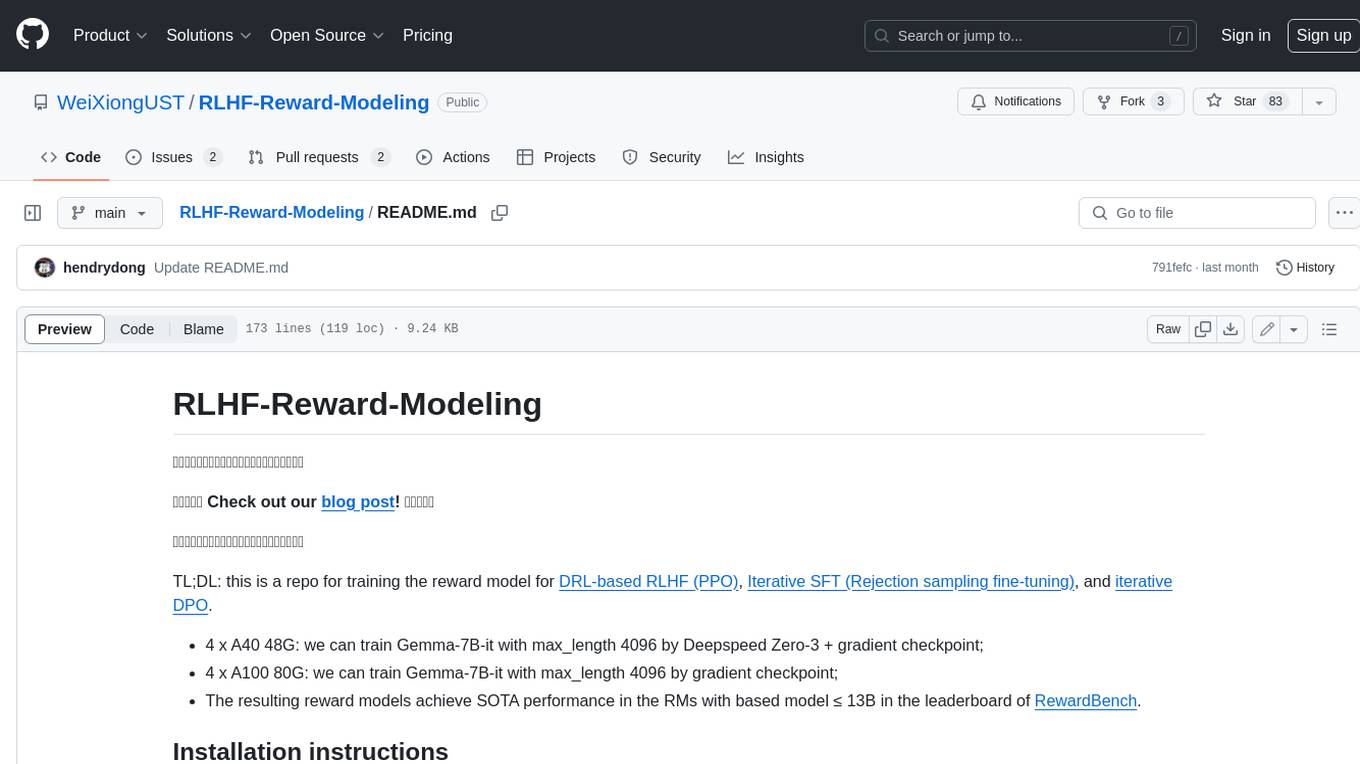
This repository contains code for training reward models for Deep Reinforcement Learning-based Reward-modulated Hierarchical Fine-tuning (DRL-based RLHF), Iterative Selection Fine-tuning (Rejection sampling fine-tuning), and iterative Decision Policy Optimization (DPO). The reward models are trained using a Bradley-Terry model based on the Gemma and Mistral language models. The resulting reward models achieve state-of-the-art performance on the RewardBench leaderboard for reward models with base models of up to 13B parameters.
README:
🔥🔥🔥🔥🔥🔥🔥🔥🔥🔥🔥🔥🔥🔥🔥🔥🔥🔥🔥🔥🔥🔥
🔥🔥🚀🚀🚀 Check out our blog post! 🚀🚀🚀🔥🔥
🔥🔥🔥🔥🔥🔥🔥🔥🔥🔥🔥🔥🔥🔥🔥🔥🔥🔥🔥🔥🔥🔥
TL;DL: this is a repo for training the reward model for DRL-based RLHF (PPO), Iterative SFT (Rejection sampling fine-tuning), and iterative DPO.
- 4 x A40 48G: we can train Gemma-7B-it with max_length 4096 by Deepspeed Zero-3 + gradient checkpoint;
- 4 x A100 80G: we can train Gemma-7B-it with max_length 4096 by gradient checkpoint;
- The resulting reward models achieve SOTA performance in the RMs with based model ≤ 13B in the leaderboard of RewardBench.
To be updated.
The current solution is based on the alignment handbook and the environment, which should be sufficient for plain RM training. Before starting, please make sure your linux machine has nvidia-cuda-toolkit installed.
conda create -n newhandbook python=3.10.9
conda activate newhandbook
git clone https://github.com/huggingface/alignment-handbook.git
cd ./alignment-handbook/
python -m pip install .
python -m pip install .
pip install flash-attn
git clone https://github.com/WeiXiongUST/RLHF-Reward-Modeling.gitSome possible problems:
CUDA_HOME may not exist, unable to compile CUDA op(s)AssertionError:[end of output]
conda install nvidia/label/cuda-12.2.0::cuda-nvccYou also need to install wandb to record the training and log in with the huggingface accout to access Gemma.
pip install wandb
wandb login
huggingface-cli loginThe dataset should be preprocessed as the standard format, where each of the sample consists of two conversations 'chosen' and 'rejected' and they share the same prompt. Here is an example of the rejected sample in the comparison pair.
[
{ "content": "Please identify the top 5 rarest animals in the world.", "role": "user" },
{ "content": "Do you mean animals that are really rare, or rare relative to the size of the human population?", "role": "assistant" },
{ "content": "The ones that are really rare.", "role": "user" },
{ "content": "Alright, here’s what I found:", "role": "assistant" },
]We preprocess 4 dataset and upload them to the hugginface hub.
- Version 1: weqweasdas/preference_dataset_mixture
- Version 2: weqweasdas/preference_dataset_mix2
- Version 3: weqweasdas/preference_dataset_mixture2_and_safe_pku
- Version 4: weqweasdas/preference_dataset_mixture2_and_safe_pku150k
- Version 5: llm-blender/Unified-Feedback
Version 1: The model is trained on a mixture1 of
The total number of the comparison pairs is 250K, where we perform the following data selection and cleaning strateges:
- HH-RLHF: we use all the base, rejection sampling, and online subsets but delete the samples whose chosen == rejected, leading to 115547;
- SHP: we only use the samples with score ratio > 2, for each prompt, we only take 1 comparison, leading to 55916;
- Ultrafeedback: similar to UltraFeedback-Binarized, we use the fine-grained score instead of the overall one to rank samples. Meanwhile, for each prompt, we take the best one v.s. random chosen one in the remaining samples. Finally, we delete the selected pairs with equal scores, leading to 62793.
- HelpSteer: we use the mean of helpfulness and correctness to rank samples. Meanwhile, we take the best sample v.s. the random chosen one in the remaining samples. Finally, we delete the selected pairs with equal scores, leading to 8206;
- Capybara: we delete the pairs whose chosen and rejected samples are of the same rating, leading to 7562;
- Orca: we delete the pairs whose chosen and rejected samples are of the same rating, leading to 6405.
Version 2: The model is also trained on a mixture2 of
Difference:
- SHP: we only use the samples with score ratio > 2, for each prompt, we take 5 comparison at most, leading to 109526;
- Ultrafeedback: similar to UltraFeedback-Binarized, we use the fine-grained score instead of the overall one to rank samples. Meanwhile, for each prompt, we take all possible 6 pairs of comparisons. Finally, we delete the selected pairs with equal scores, leading to 267416.
- HelpSteer: we use the mean of helpfulness and correctness to rank samples. Meanwhile, we take all possible 6 pairs of comparisons. Finally, we delete the selected pairs with equal scores, leading to 21576;
Version 3: Mixture2 + 30K safety is the mixture2 + the training set of PKU-Alignment/PKU-SafeRLHF-30K
Version 4: 1 Mixture2 + 150K safety is the mixture2 + 150K samples from PKU-Alignment/PKU-SafeRLHF
Version 5 Directly leverage the dataset from llm-blender/Unified-Feedback, which includes 886K preference samples from 8 prior datasets: openai/summarize_from_feedback, openai/webgpt_comparisons, Dahoas/instruct-synthetic-prompt-responses, Anthropic/hh-rlhf, lmsys/chatbot_arena_conversations, openbmb/UltraFeedback, argilla/ultrafeedback-binarized-preferences-cleaned, berkeley-nest/Nectar.
Running the code with Gemma-2b-it.
accelerate launch rm.py --model_name google/gemma-2b-it --max_length 4096 --train_set_path weqweasdas/preference_dataset_mix2You can also modify the learning rate, batch size, output_path.. with either command or modify the ScriptArguments in the rm_gemma.py
If you encounter out-of-memory issue. Running the code with Gemma-2b-it with deepspeed stage 3. If OOM still exists, use a smaller max length and per_device_batch_size.
accelerate launch rm.py --model_name google/gemma-2b-it --max_length 4096 --train_set_path weqweasdas/preference_dataset_mix2 --deepspeed deepspeed_3.jsonREMARK: note that with deepspeed stage 3, the final mode saving does not work normally. You should set the save_every_steps as the total number of training steps - 1 so that the trainer will save a model for you just before finishing the training.
You can evaluate the resulting reward model with the dataset provided by benchmark by the following command.
accelerate launch eval_bench_mark.py --reward_name_or_path ./models/gemma_2b_mixture2_last_checkpoint --record_dir ./bench_mark_eval.txtSome models trained by our script are competitive in the leaderboard.
- [x] Bradley-Terry Reward Model based on Gemma and Mistral.
- [ ] Bradley-Terry Reward Model based on Mixtral;
- [ ] Preference model;
- [ ] Regression-based reward model;
- [ ] Multi-objective reward model.
The repo was part of the iterative rejection sampling fine-tuning and iterative DPO. If you find the content of this repo useful in your work, please consider cite it as follows:
@article{dong2023raft,
title={Raft: Reward ranked finetuning for generative foundation model alignment},
author={Dong, Hanze and Xiong, Wei and Goyal, Deepanshu and Pan, Rui and Diao, Shizhe and Zhang, Jipeng and Shum, Kashun and Zhang, Tong},
journal={arXiv preprint arXiv:2304.06767},
year={2023}
}
@misc{xiong2024iterative,
title={Iterative Preference Learning from Human Feedback: Bridging Theory and Practice for RLHF under KL-Constraint},
author={Wei Xiong and Hanze Dong and Chenlu Ye and Ziqi Wang and Han Zhong and Heng Ji and Nan Jiang and Tong Zhang},
year={2024},
eprint={2312.11456},
archivePrefix={arXiv},
primaryClass={cs.LG}
}For Tasks:
Click tags to check more tools for each tasksFor Jobs:
Alternative AI tools for RLHF-Reward-Modeling
Similar Open Source Tools

RLHF-Reward-Modeling
This repository contains code for training reward models for Deep Reinforcement Learning-based Reward-modulated Hierarchical Fine-tuning (DRL-based RLHF), Iterative Selection Fine-tuning (Rejection sampling fine-tuning), and iterative Decision Policy Optimization (DPO). The reward models are trained using a Bradley-Terry model based on the Gemma and Mistral language models. The resulting reward models achieve state-of-the-art performance on the RewardBench leaderboard for reward models with base models of up to 13B parameters.
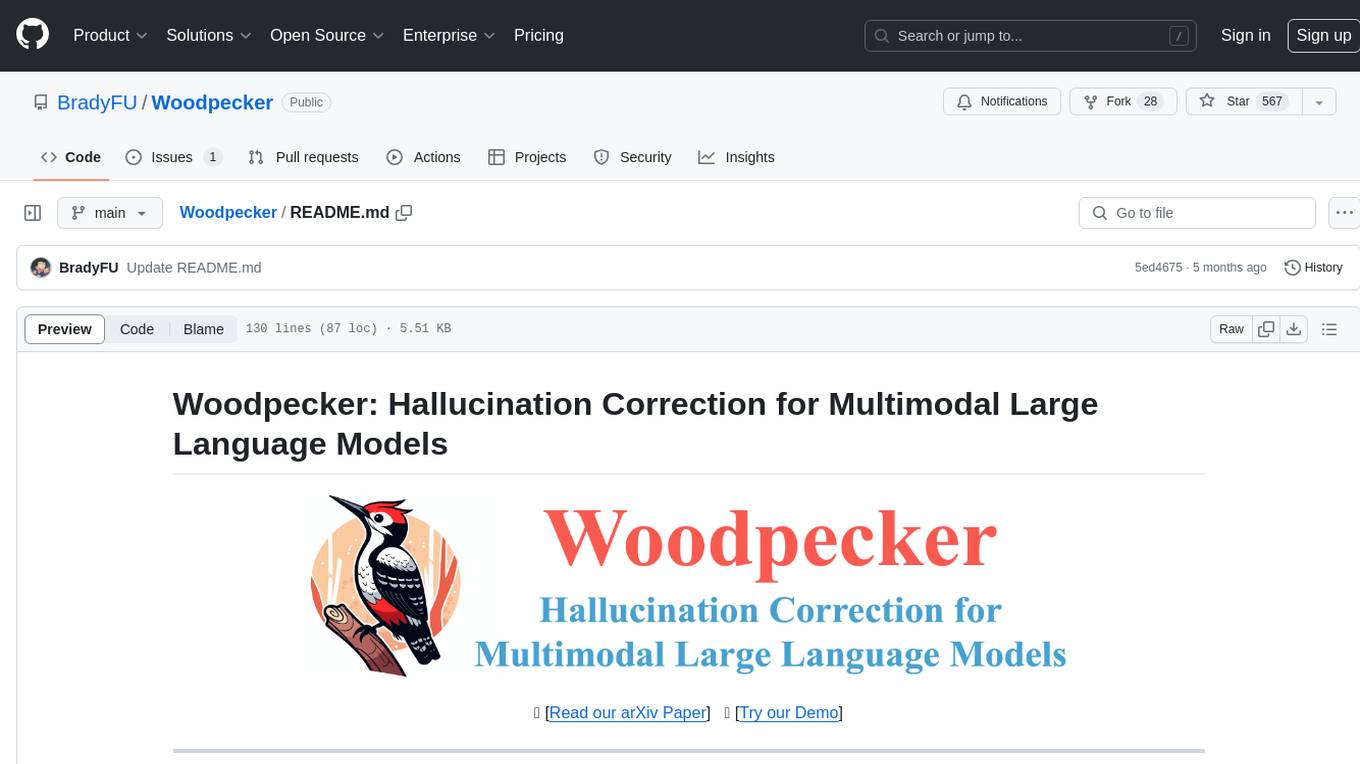
Woodpecker
Woodpecker is a tool designed to correct hallucinations in Multimodal Large Language Models (MLLMs) by introducing a training-free method that picks out and corrects inconsistencies between generated text and image content. It consists of five stages: key concept extraction, question formulation, visual knowledge validation, visual claim generation, and hallucination correction. Woodpecker can be easily integrated with different MLLMs and provides interpretable results by accessing intermediate outputs of the stages. The tool has shown significant improvements in accuracy over baseline models like MiniGPT-4 and mPLUG-Owl.
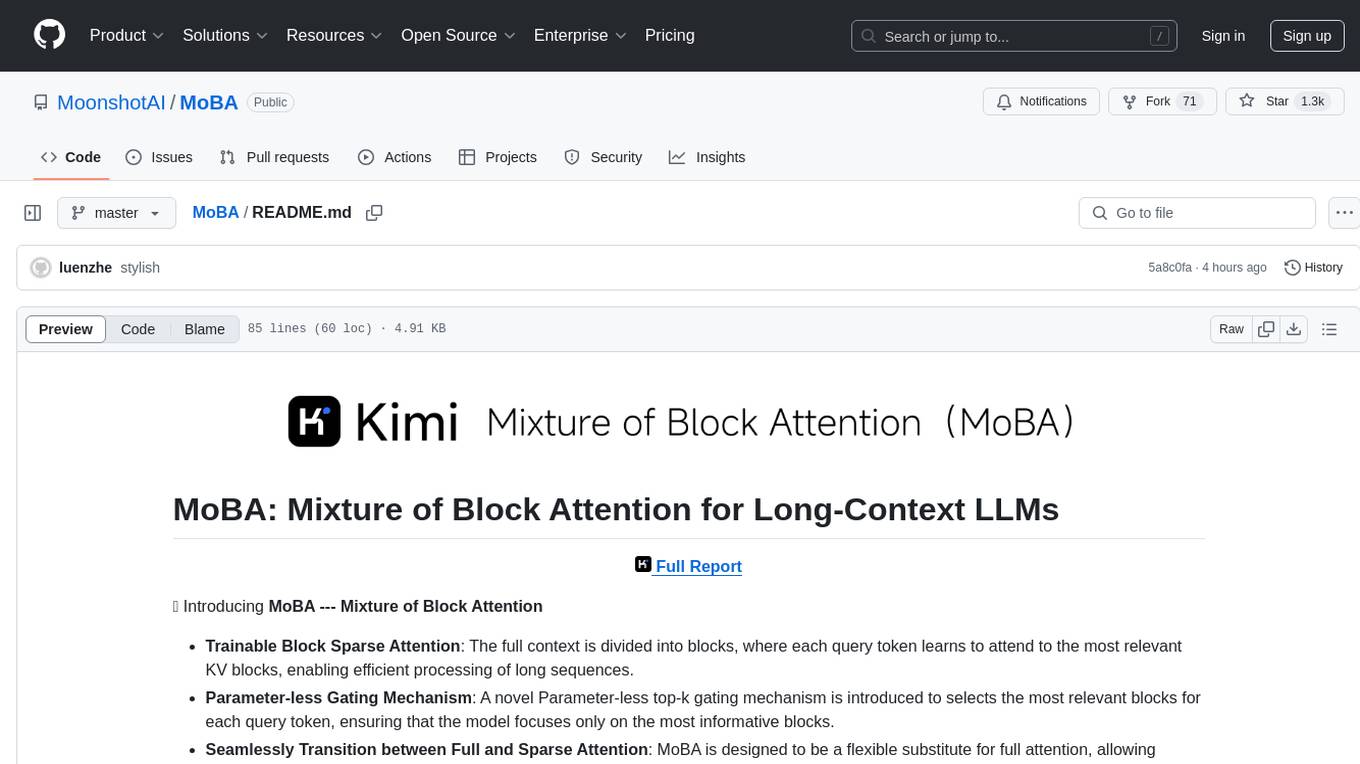
MoBA
MoBA (Mixture of Block Attention) is an innovative approach for long-context language models, enabling efficient processing of long sequences by dividing the full context into blocks and introducing a parameter-less gating mechanism. It allows seamless transitions between full and sparse attention modes, enhancing efficiency without compromising performance. MoBA has been deployed to support long-context requests and demonstrates significant advancements in efficient attention computation for large language models.
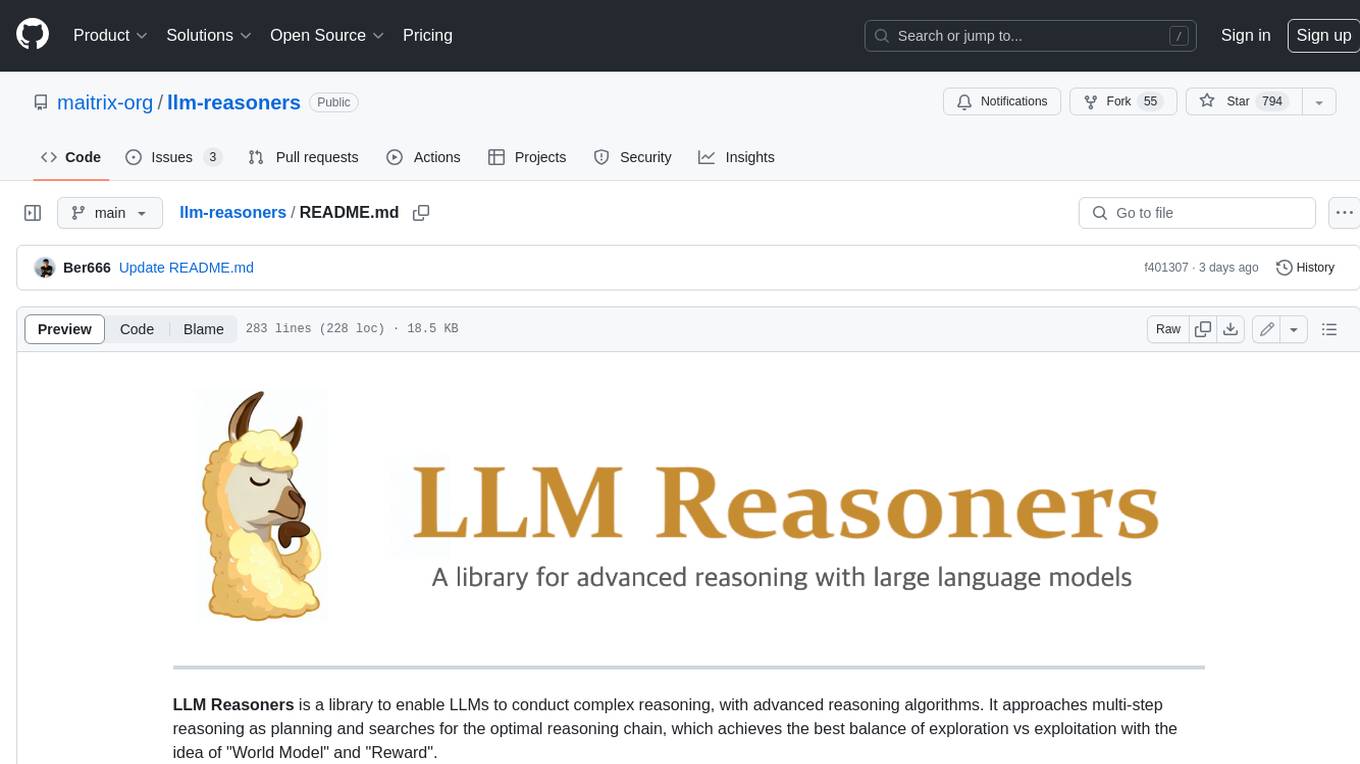
llm-reasoners
LLM Reasoners is a library that enables LLMs to conduct complex reasoning, with advanced reasoning algorithms. It approaches multi-step reasoning as planning and searches for the optimal reasoning chain, which achieves the best balance of exploration vs exploitation with the idea of "World Model" and "Reward". Given any reasoning problem, simply define the reward function and an optional world model (explained below), and let LLM reasoners take care of the rest, including Reasoning Algorithms, Visualization, LLM calling, and more!
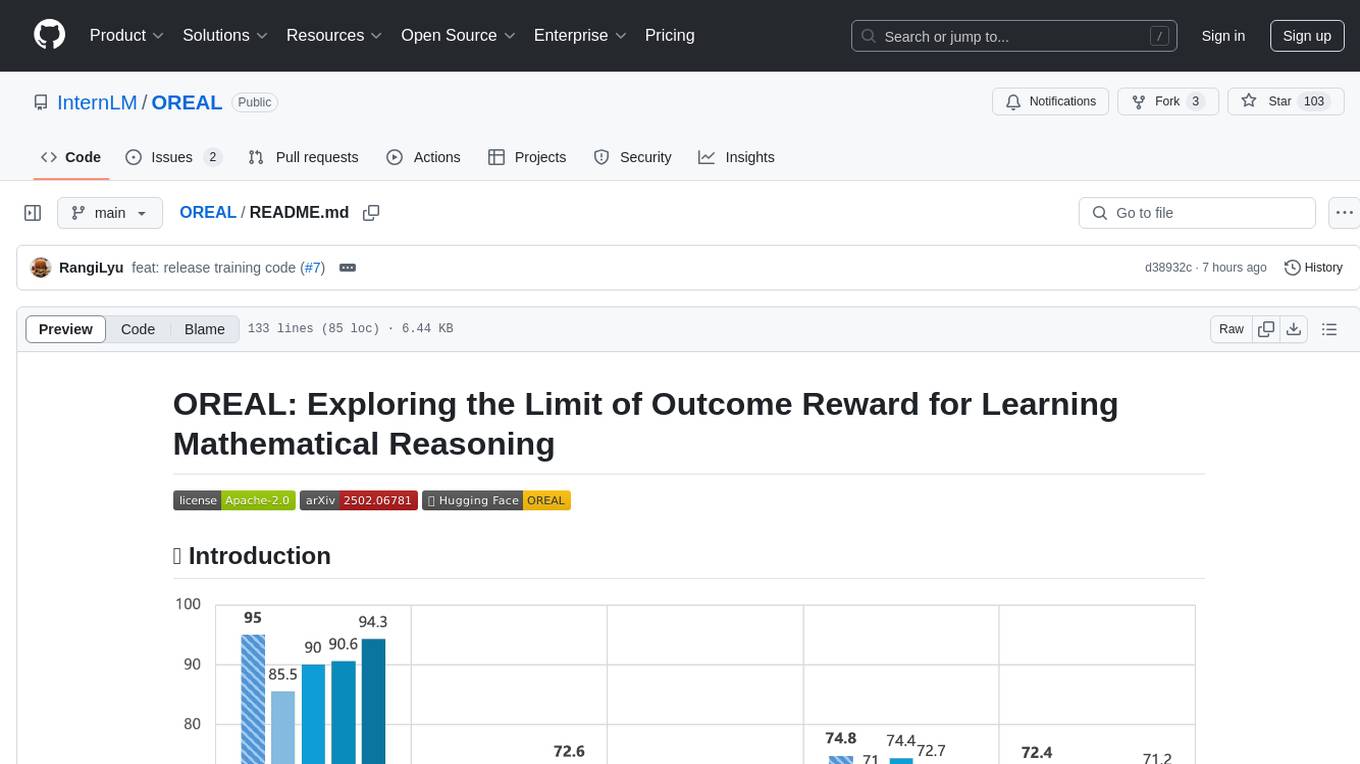
OREAL
OREAL is a reinforcement learning framework designed for mathematical reasoning tasks, aiming to achieve optimal performance through outcome reward-based learning. The framework utilizes behavior cloning, reshaping rewards, and token-level reward models to address challenges in sparse rewards and partial correctness. OREAL has achieved significant results, with a 7B model reaching 94.0 pass@1 accuracy on MATH-500 and surpassing previous 32B models. The tool provides training tutorials and Hugging Face model repositories for easy access and implementation.
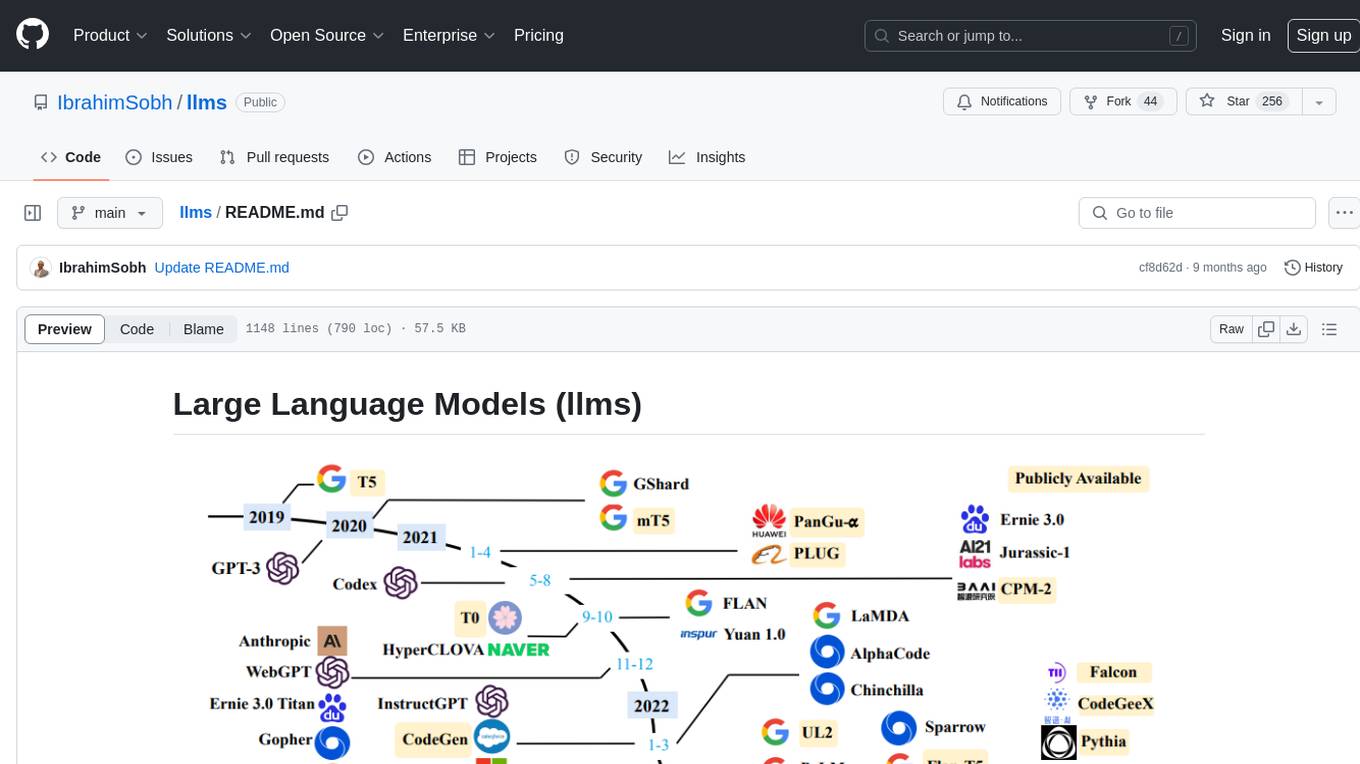
llms
The 'llms' repository is a comprehensive guide on Large Language Models (LLMs), covering topics such as language modeling, applications of LLMs, statistical language modeling, neural language models, conditional language models, evaluation methods, transformer-based language models, practical LLMs like GPT and BERT, prompt engineering, fine-tuning LLMs, retrieval augmented generation, AI agents, and LLMs for computer vision. The repository provides detailed explanations, examples, and tools for working with LLMs.
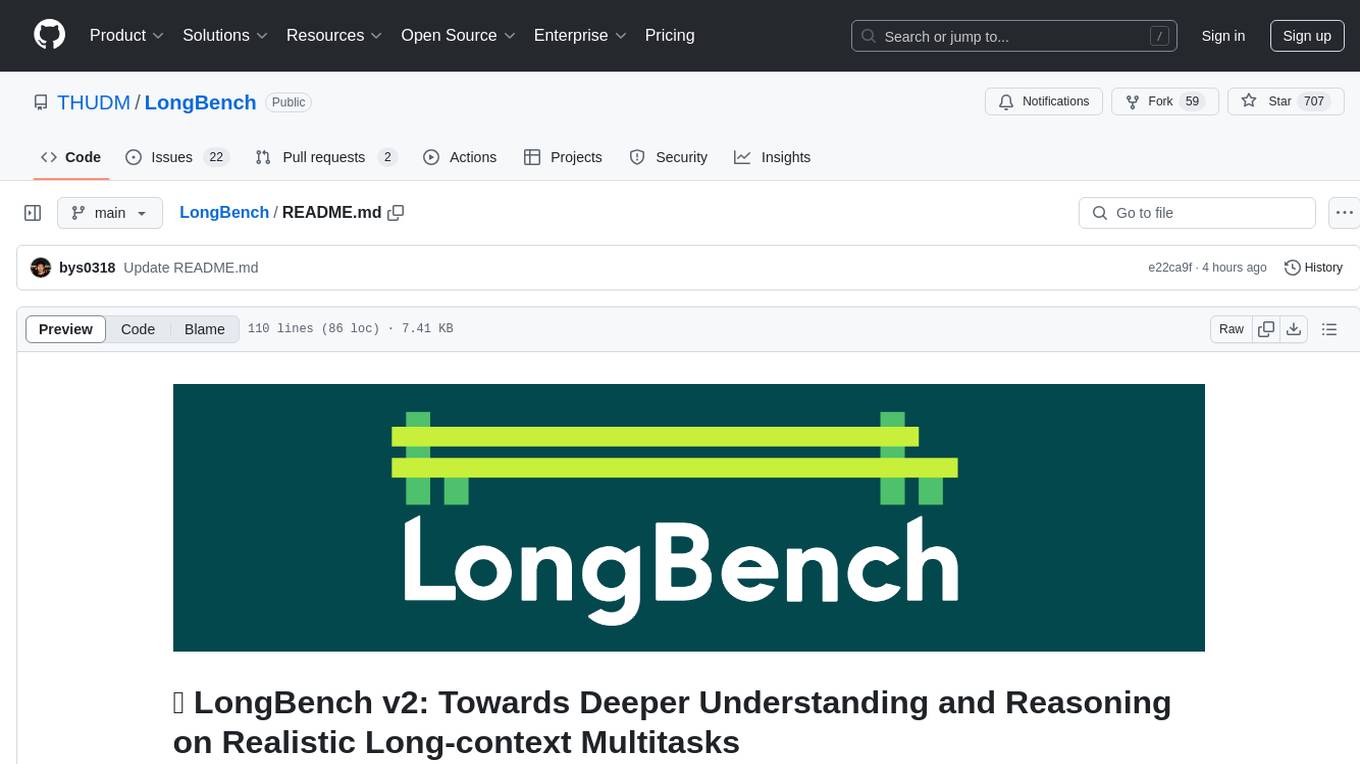
LongBench
LongBench v2 is a benchmark designed to assess the ability of large language models (LLMs) to handle long-context problems requiring deep understanding and reasoning across various real-world multitasks. It consists of 503 challenging multiple-choice questions with contexts ranging from 8k to 2M words, covering six major task categories. The dataset is collected from nearly 100 highly educated individuals with diverse professional backgrounds and is designed to be challenging even for human experts. The evaluation results highlight the importance of enhanced reasoning ability and scaling inference-time compute to tackle the long-context challenges in LongBench v2.
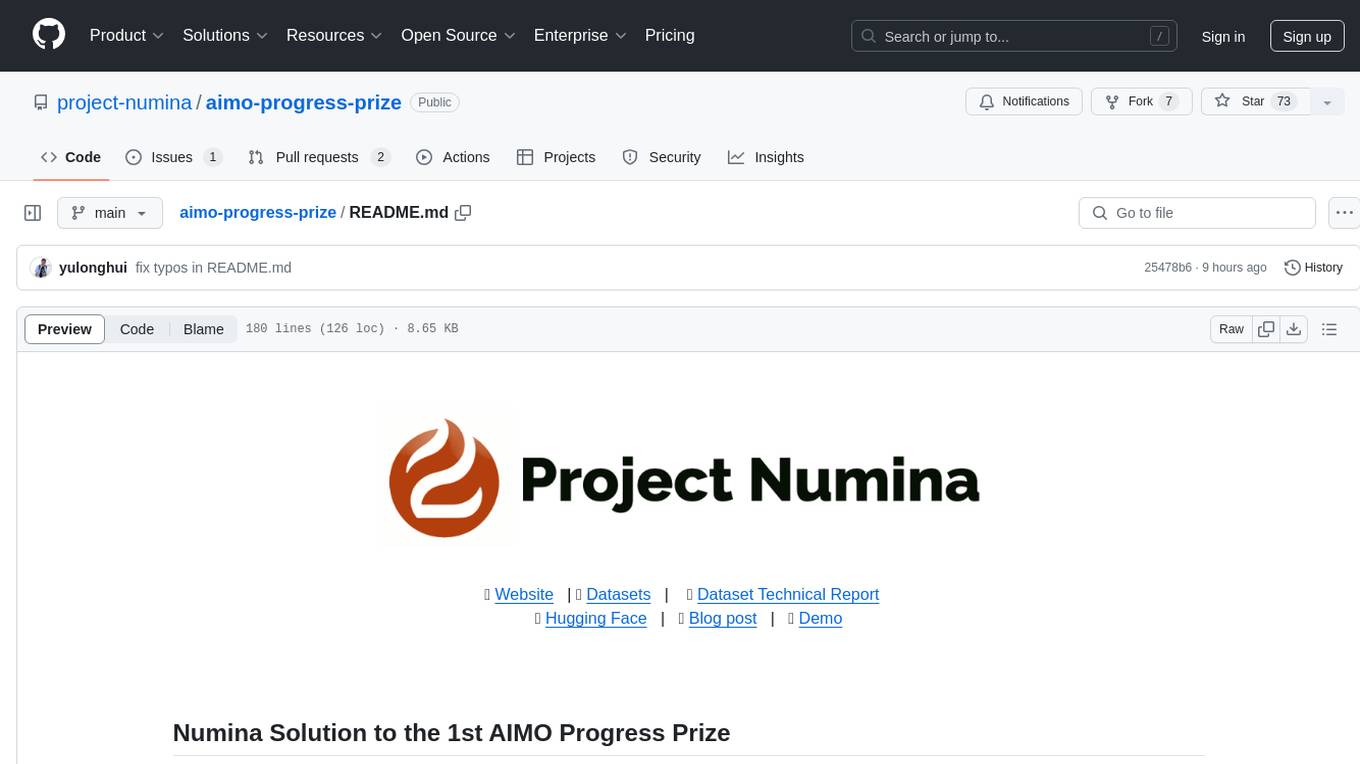
aimo-progress-prize
This repository contains the training and inference code needed to replicate the winning solution to the AI Mathematical Olympiad - Progress Prize 1. It consists of fine-tuning DeepSeekMath-Base 7B, high-quality training datasets, a self-consistency decoding algorithm, and carefully chosen validation sets. The training methodology involves Chain of Thought (CoT) and Tool Integrated Reasoning (TIR) training stages. Two datasets, NuminaMath-CoT and NuminaMath-TIR, were used to fine-tune the models. The models were trained using open-source libraries like TRL, PyTorch, vLLM, and DeepSpeed. Post-training quantization to 8-bit precision was done to improve performance on Kaggle's T4 GPUs. The project structure includes scripts for training, quantization, and inference, along with necessary installation instructions and hardware/software specifications.
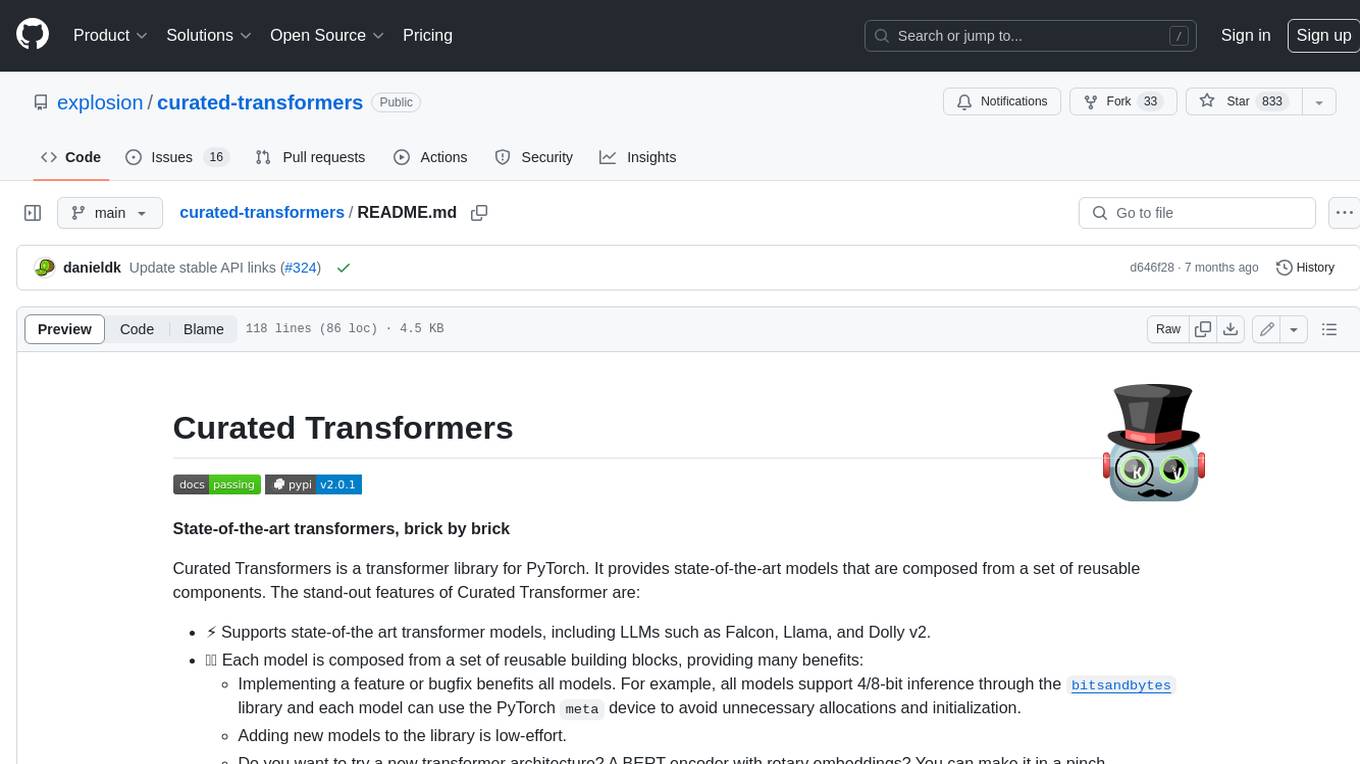
curated-transformers
Curated Transformers is a transformer library for PyTorch that provides state-of-the-art models composed of reusable components. It supports various transformer architectures, including encoders like ALBERT, BERT, and RoBERTa, and decoders like Falcon, Llama, and MPT. The library emphasizes consistent type annotations, minimal dependencies, and ease of use for education and research. It has been production-tested by Explosion and will be the default transformer implementation in spaCy 3.7.
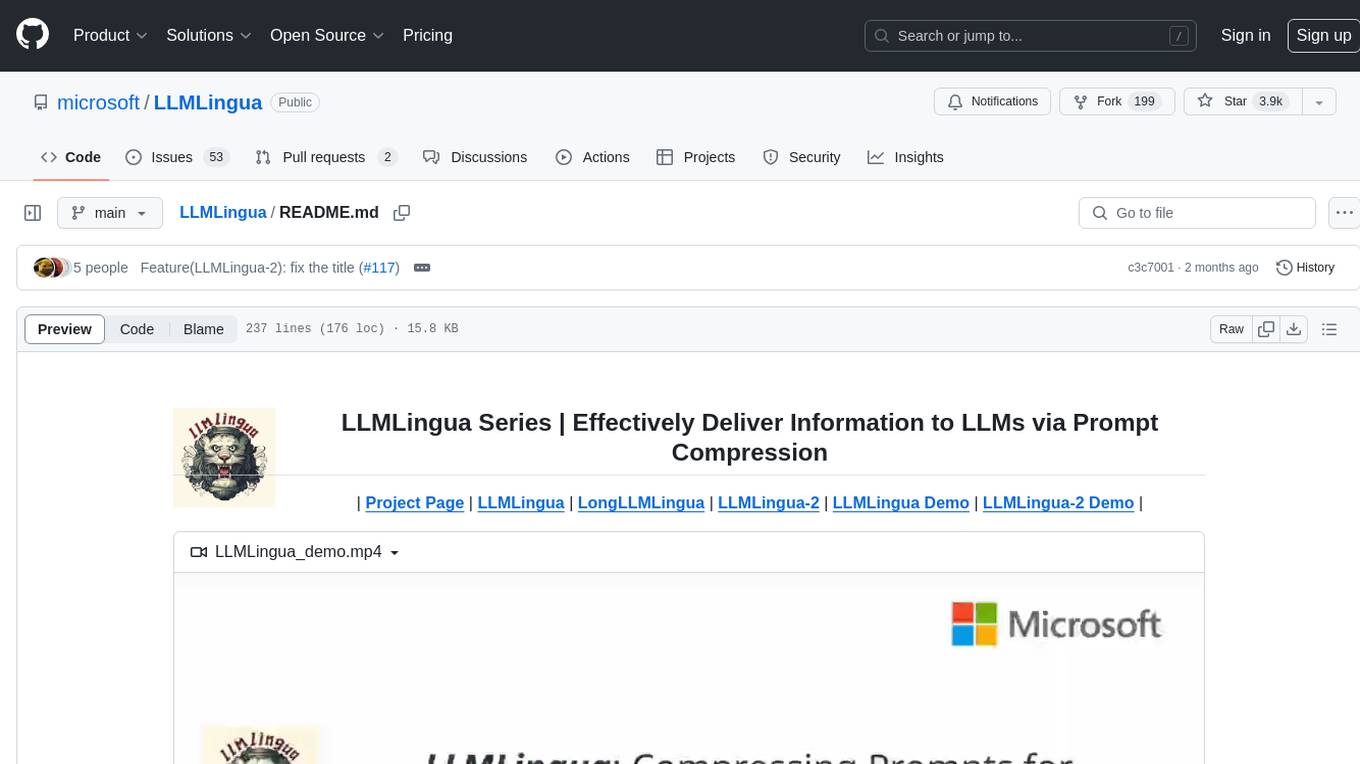
LLMLingua
LLMLingua is a tool that utilizes a compact, well-trained language model to identify and remove non-essential tokens in prompts. This approach enables efficient inference with large language models, achieving up to 20x compression with minimal performance loss. The tool includes LLMLingua, LongLLMLingua, and LLMLingua-2, each offering different levels of prompt compression and performance improvements for tasks involving large language models.
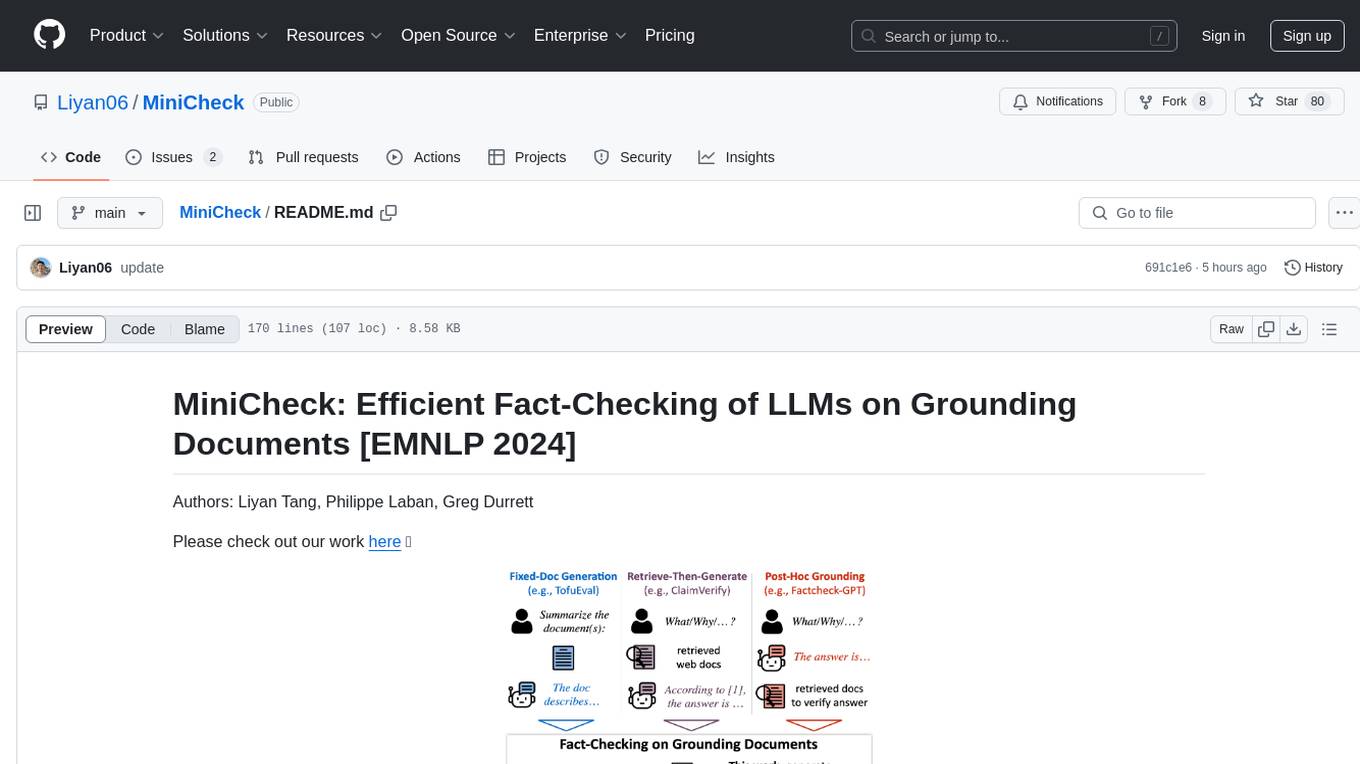
MiniCheck
MiniCheck is an efficient fact-checking tool designed to verify claims against grounding documents using large language models. It provides a sentence-level fact-checking model that can be used to evaluate the consistency of claims with the provided documents. MiniCheck offers different models, including Bespoke-MiniCheck-7B, which is the state-of-the-art and commercially usable. The tool enables users to fact-check multi-sentence claims by breaking them down into individual sentences for optimal performance. It also supports automatic prefix caching for faster inference when repeatedly fact-checking the same document with different claims.
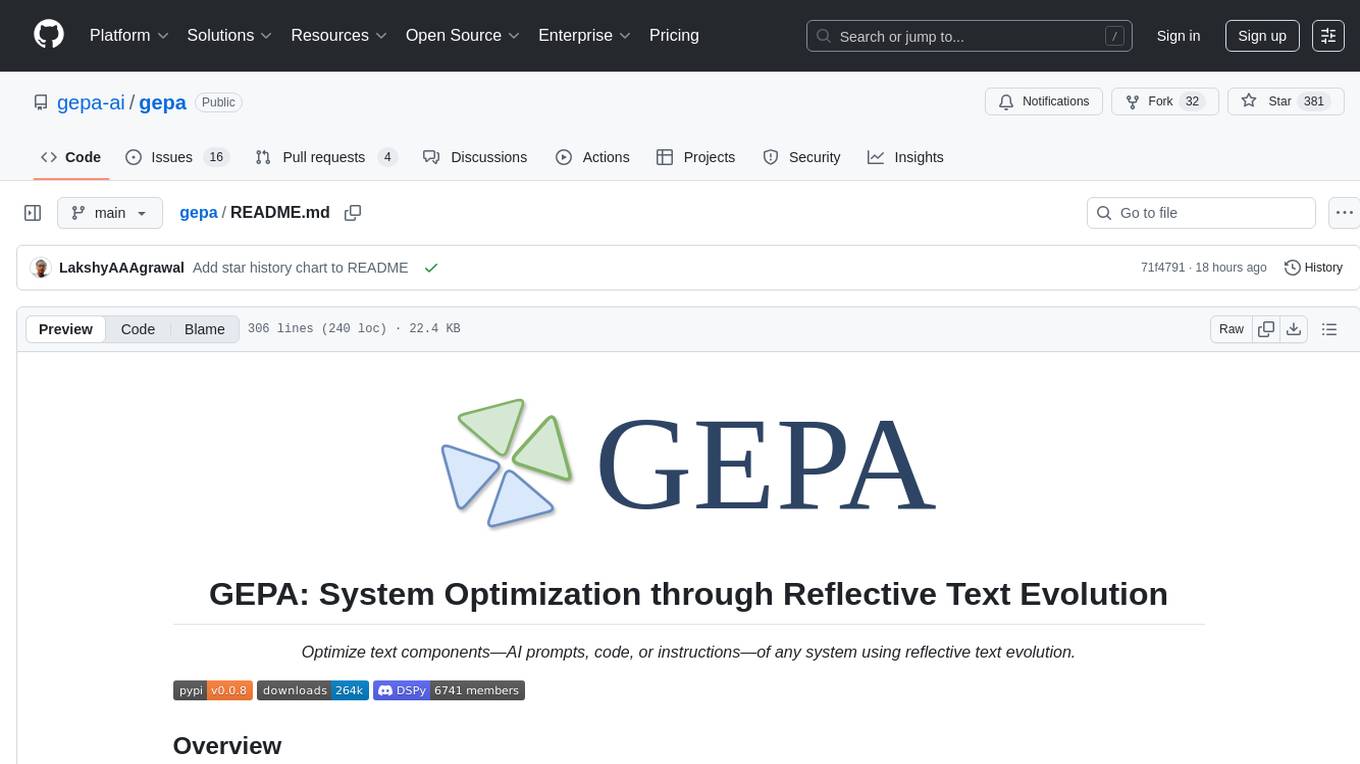
gepa
GEPA (Genetic-Pareto) is a framework for optimizing arbitrary systems composed of text components like AI prompts, code snippets, or textual specs against any evaluation metric. It employs LLMs to reflect on system behavior, using feedback from execution and evaluation traces to drive targeted improvements. Through iterative mutation, reflection, and Pareto-aware candidate selection, GEPA evolves robust, high-performing variants with minimal evaluations, co-evolving multiple components in modular systems for domain-specific gains. The repository provides the official implementation of the GEPA algorithm as proposed in the paper titled 'GEPA: Reflective Prompt Evolution Can Outperform Reinforcement Learning'.
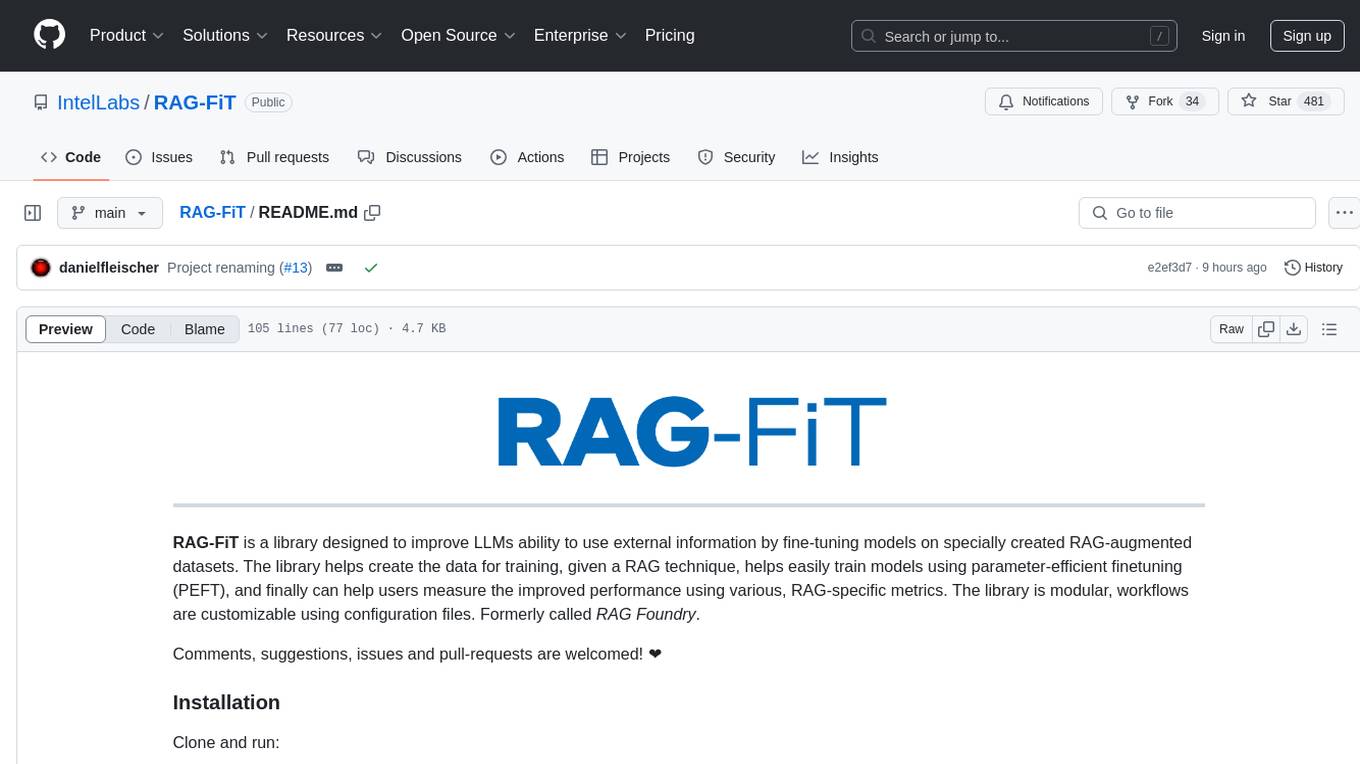
RAG-FiT
RAG-FiT is a library designed to improve Language Models' ability to use external information by fine-tuning models on specially created RAG-augmented datasets. The library assists in creating training data, training models using parameter-efficient finetuning (PEFT), and evaluating performance using RAG-specific metrics. It is modular, customizable via configuration files, and facilitates fast prototyping and experimentation with various RAG settings and configurations.
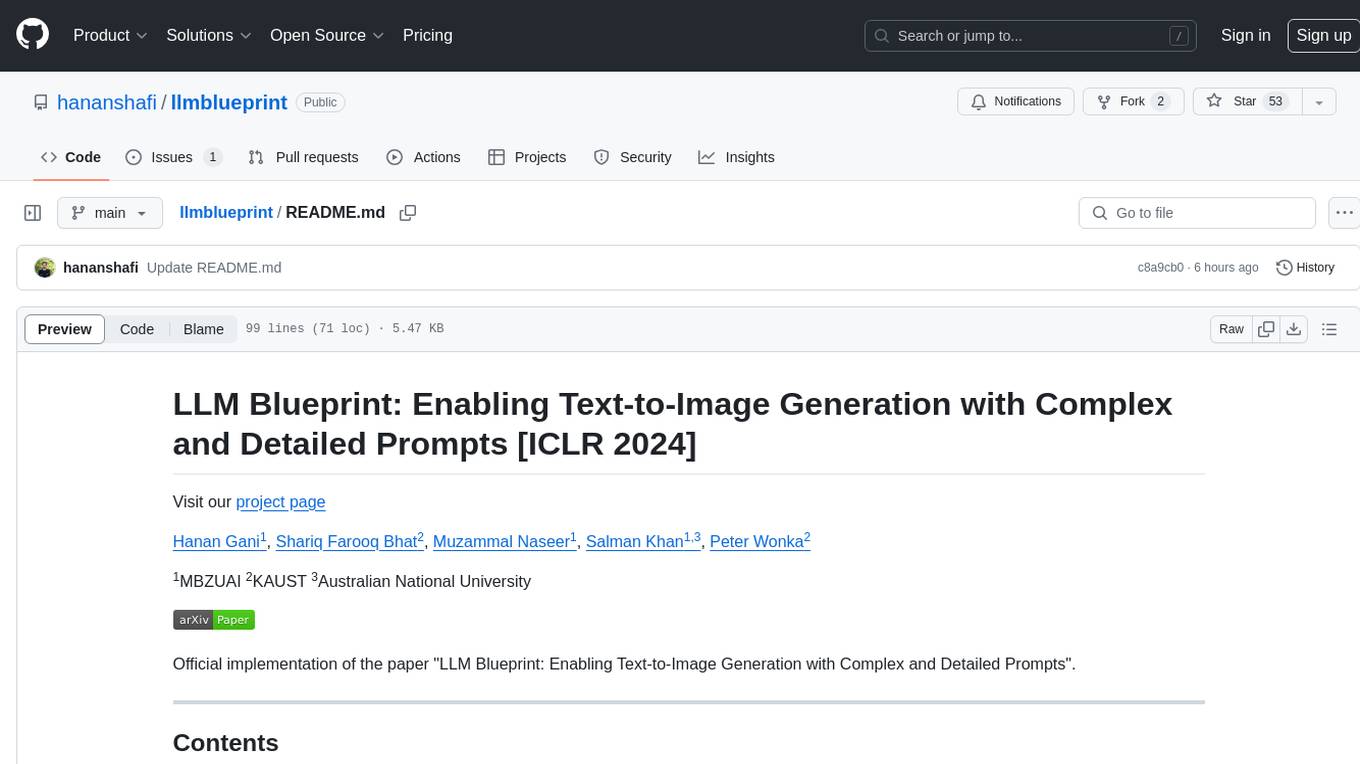
llmblueprint
LLM Blueprint is an official implementation of a paper that enables text-to-image generation with complex and detailed prompts. It leverages Large Language Models (LLMs) to extract critical components from text prompts, including bounding box coordinates for foreground objects, detailed textual descriptions for individual objects, and a succinct background context. The tool operates in two phases: Global Scene Generation creates an initial scene using object layouts and background context, and an Iterative Refinement Scheme refines box-level content to align with textual descriptions, ensuring consistency and improving recall compared to baseline diffusion models.
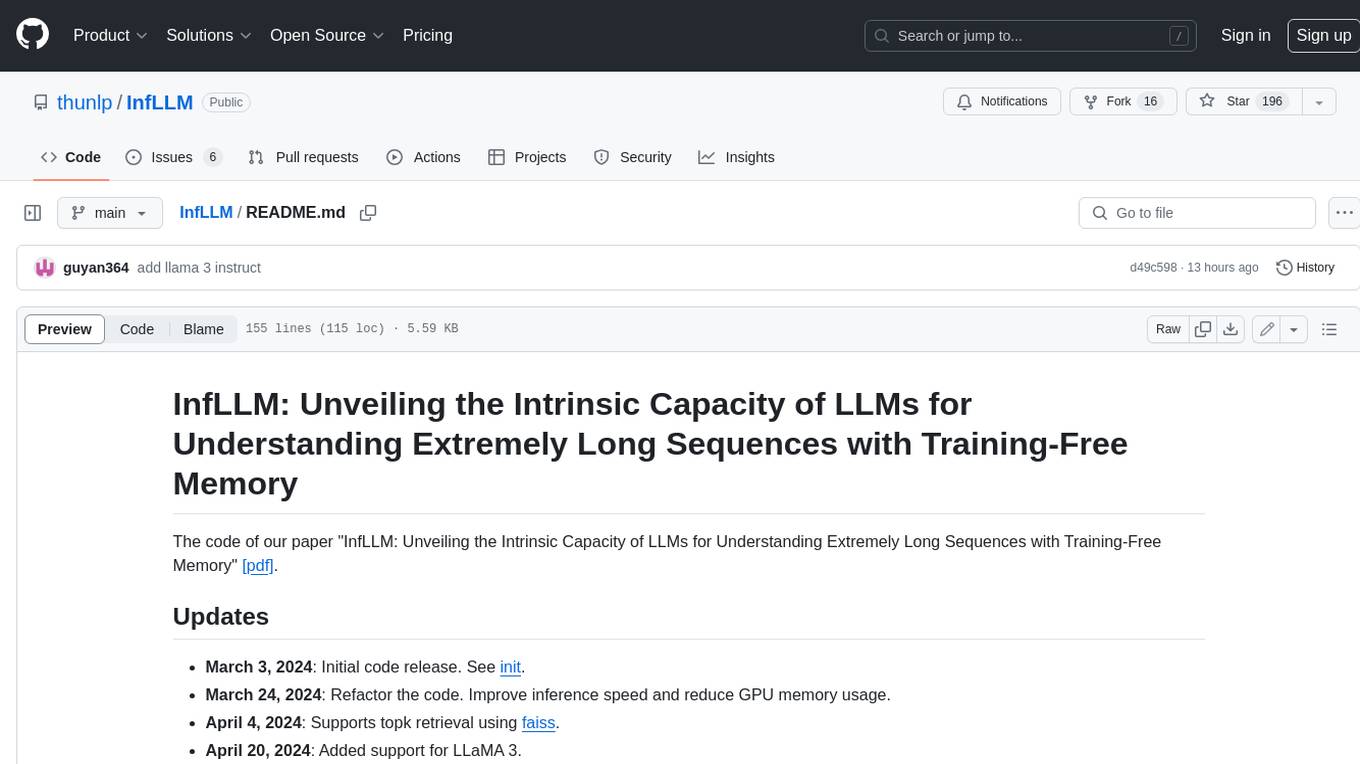
InfLLM
InfLLM is a training-free memory-based method that unveils the intrinsic ability of LLMs to process streaming long sequences. It stores distant contexts into additional memory units and employs an efficient mechanism to lookup token-relevant units for attention computation. Thereby, InfLLM allows LLMs to efficiently process long sequences while maintaining the ability to capture long-distance dependencies. Without any training, InfLLM enables LLMs pre-trained on sequences of a few thousand tokens to achieve superior performance than competitive baselines continually training these LLMs on long sequences. Even when the sequence length is scaled to 1, 024K, InfLLM still effectively captures long-distance dependencies.
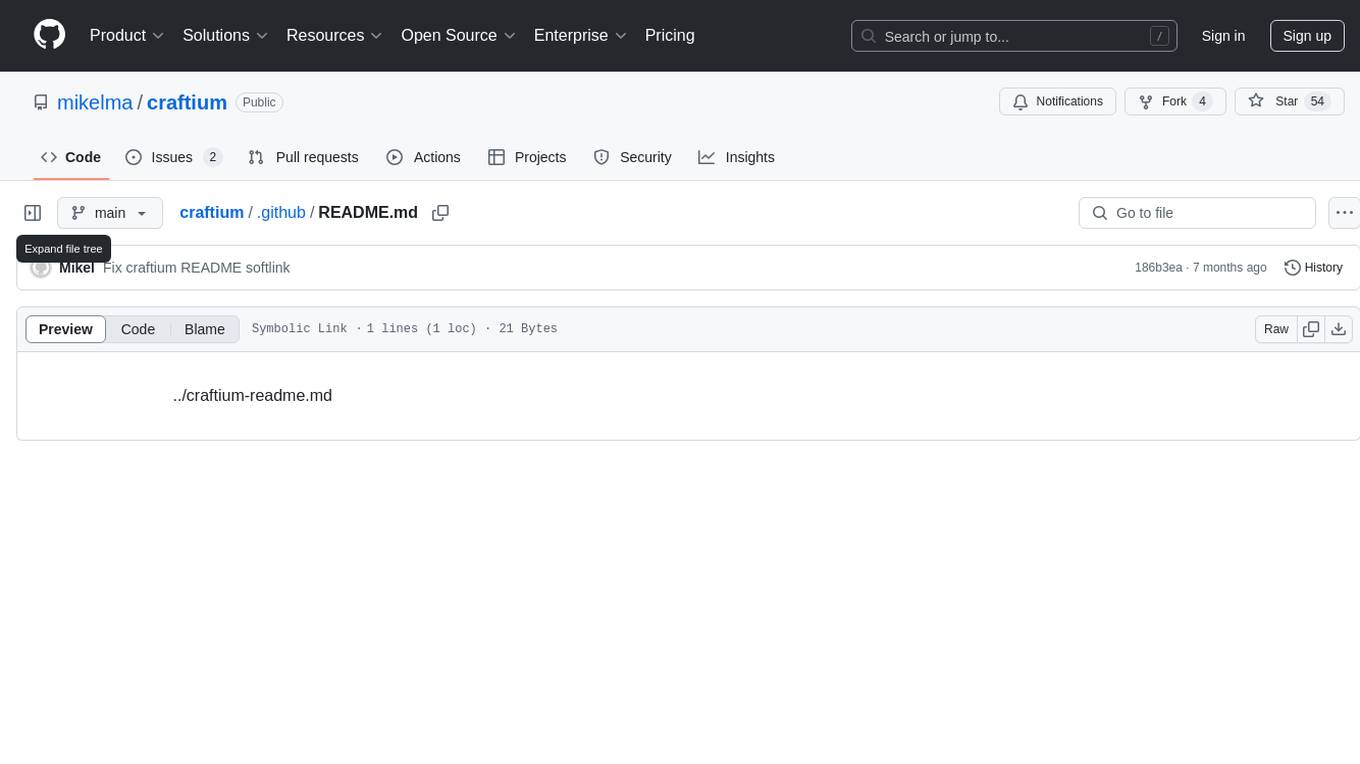
craftium
Craftium is an open-source platform based on the Minetest voxel game engine and the Gymnasium and PettingZoo APIs, designed for creating fast, rich, and diverse single and multi-agent environments. It allows for connecting to Craftium's Python process, executing actions as keyboard and mouse controls, extending the Lua API for creating RL environments and tasks, and supporting client/server synchronization for slow agents. Craftium is fully extensible, extensively documented, modern RL API compatible, fully open source, and eliminates the need for Java. It offers a variety of environments for research and development in reinforcement learning.
For similar tasks

RLHF-Reward-Modeling
This repository contains code for training reward models for Deep Reinforcement Learning-based Reward-modulated Hierarchical Fine-tuning (DRL-based RLHF), Iterative Selection Fine-tuning (Rejection sampling fine-tuning), and iterative Decision Policy Optimization (DPO). The reward models are trained using a Bradley-Terry model based on the Gemma and Mistral language models. The resulting reward models achieve state-of-the-art performance on the RewardBench leaderboard for reward models with base models of up to 13B parameters.
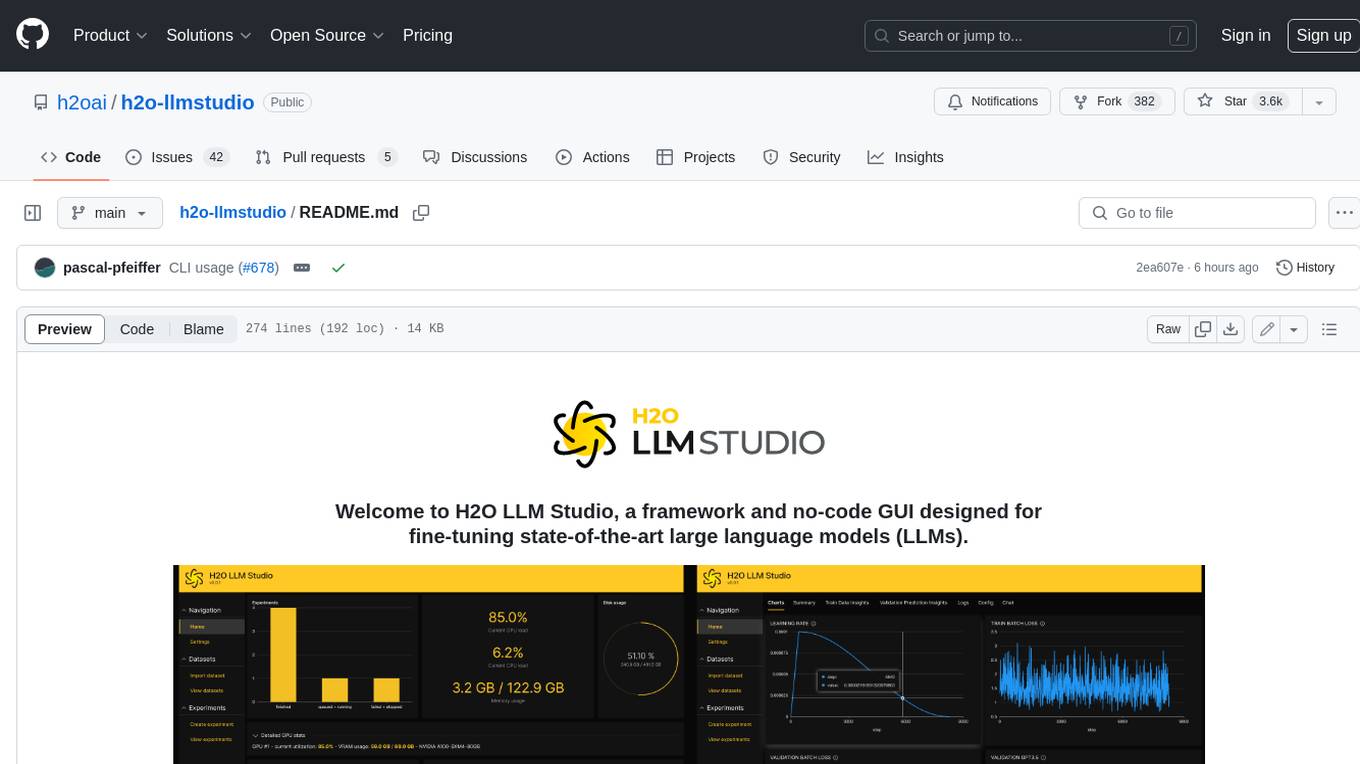
h2o-llmstudio
H2O LLM Studio is a framework and no-code GUI designed for fine-tuning state-of-the-art large language models (LLMs). With H2O LLM Studio, you can easily and effectively fine-tune LLMs without the need for any coding experience. The GUI is specially designed for large language models, and you can finetune any LLM using a large variety of hyperparameters. You can also use recent finetuning techniques such as Low-Rank Adaptation (LoRA) and 8-bit model training with a low memory footprint. Additionally, you can use Reinforcement Learning (RL) to finetune your model (experimental), use advanced evaluation metrics to judge generated answers by the model, track and compare your model performance visually, and easily export your model to the Hugging Face Hub and share it with the community.
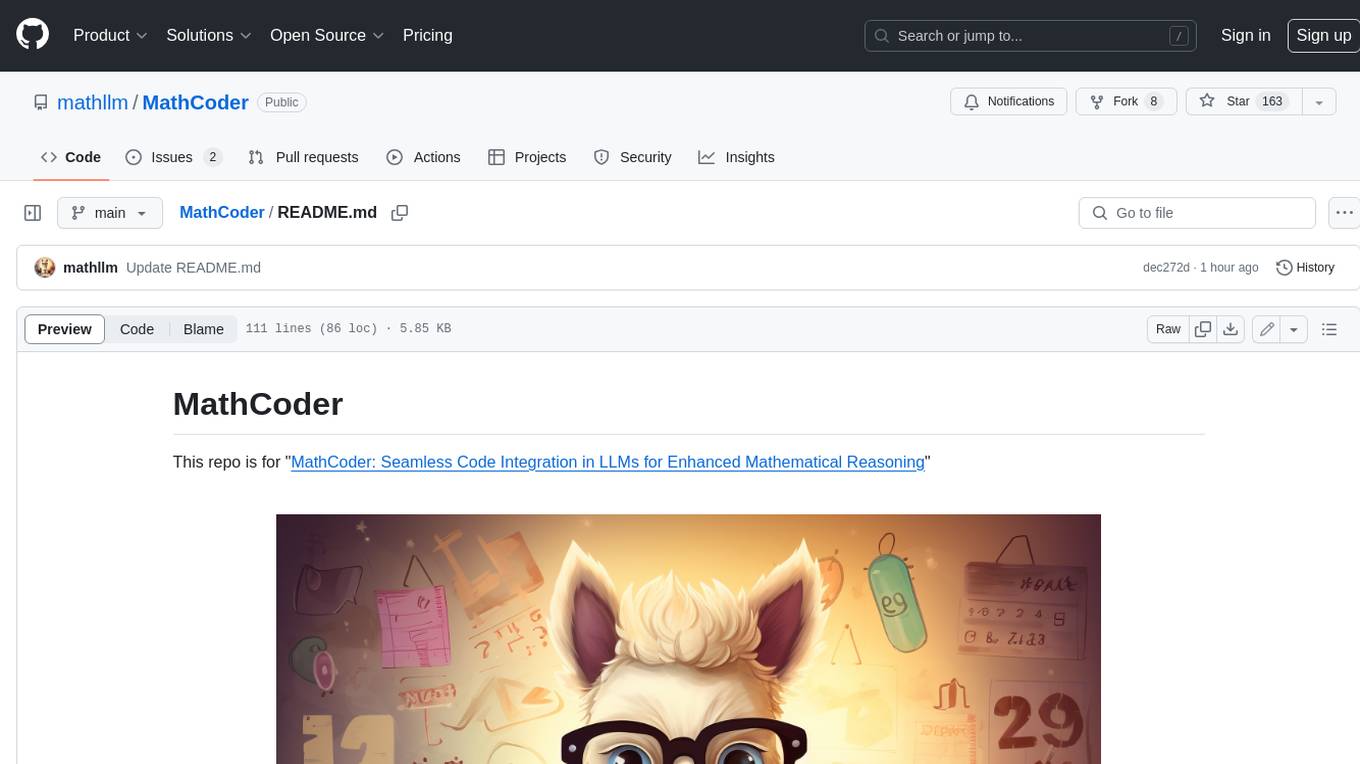
MathCoder
MathCoder is a repository focused on enhancing mathematical reasoning by fine-tuning open-source language models to use code for modeling and deriving math equations. It introduces MathCodeInstruct dataset with solutions interleaving natural language, code, and execution results. The repository provides MathCoder models capable of generating code-based solutions for challenging math problems, achieving state-of-the-art scores on MATH and GSM8K datasets. It offers tools for model deployment, inference, and evaluation, along with a citation for referencing the work.
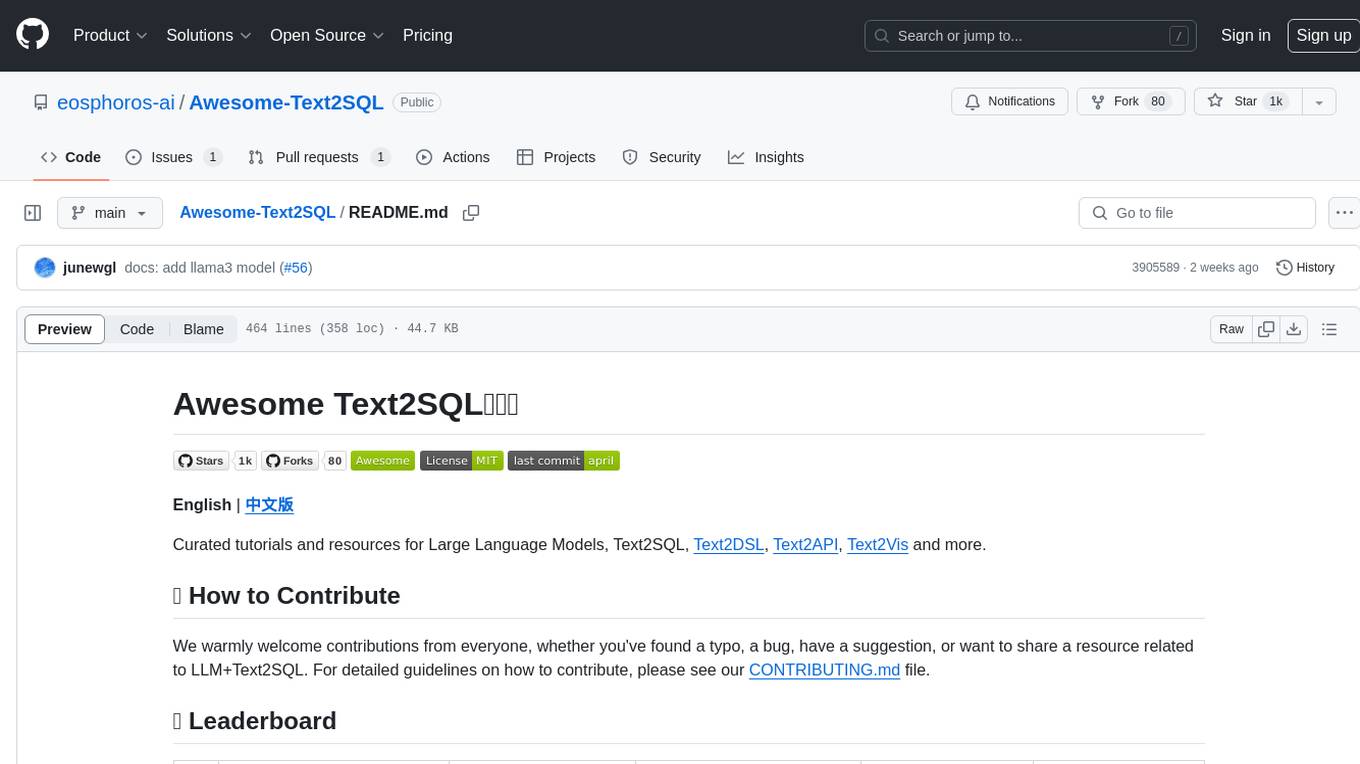
Awesome-Text2SQL
Awesome Text2SQL is a curated repository containing tutorials and resources for Large Language Models, Text2SQL, Text2DSL, Text2API, Text2Vis, and more. It provides guidelines on converting natural language questions into structured SQL queries, with a focus on NL2SQL. The repository includes information on various models, datasets, evaluation metrics, fine-tuning methods, libraries, and practice projects related to Text2SQL. It serves as a comprehensive resource for individuals interested in working with Text2SQL and related technologies.
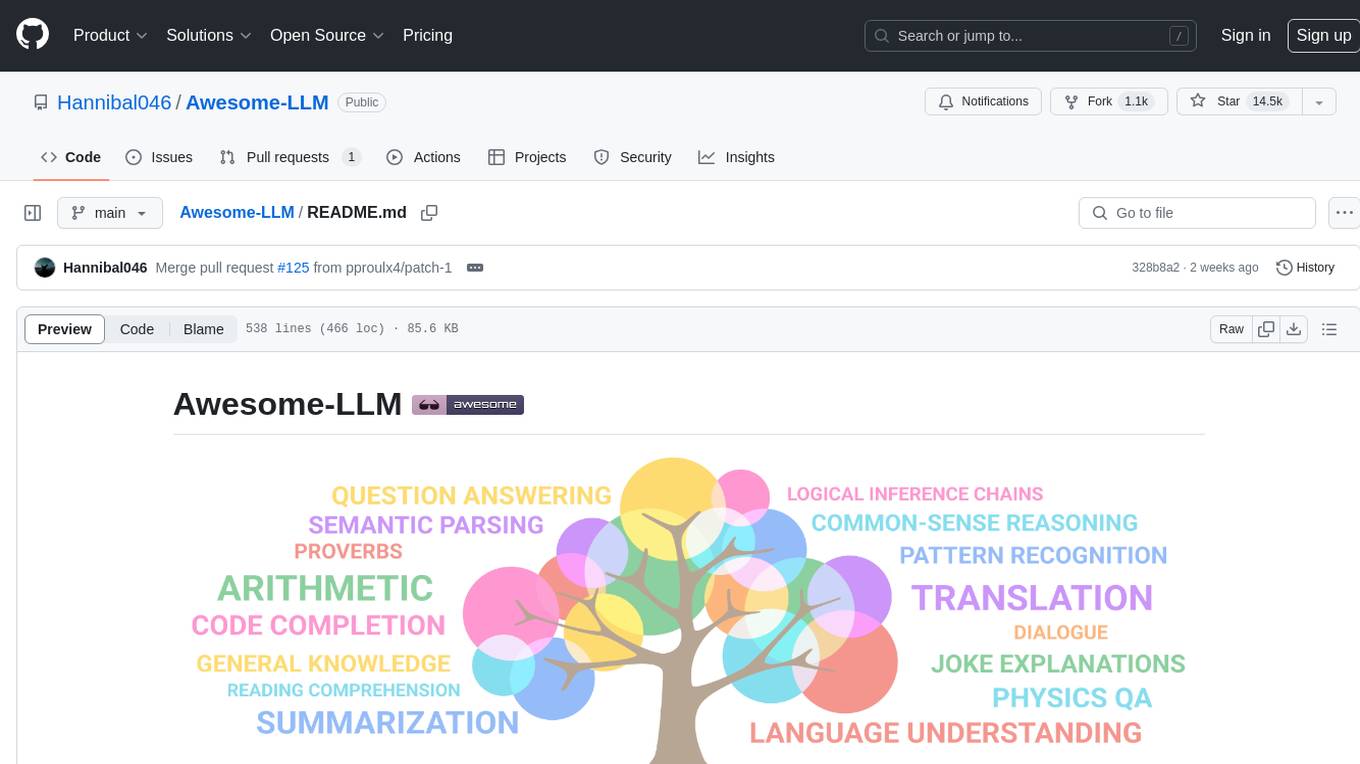
Awesome-LLM
Awesome-LLM is a curated list of resources related to large language models, focusing on papers, projects, frameworks, tools, tutorials, courses, opinions, and other useful resources in the field. It covers trending LLM projects, milestone papers, other papers, open LLM projects, LLM training frameworks, LLM evaluation frameworks, tools for deploying LLM, prompting libraries & tools, tutorials, courses, books, and opinions. The repository provides a comprehensive overview of the latest advancements and resources in the field of large language models.
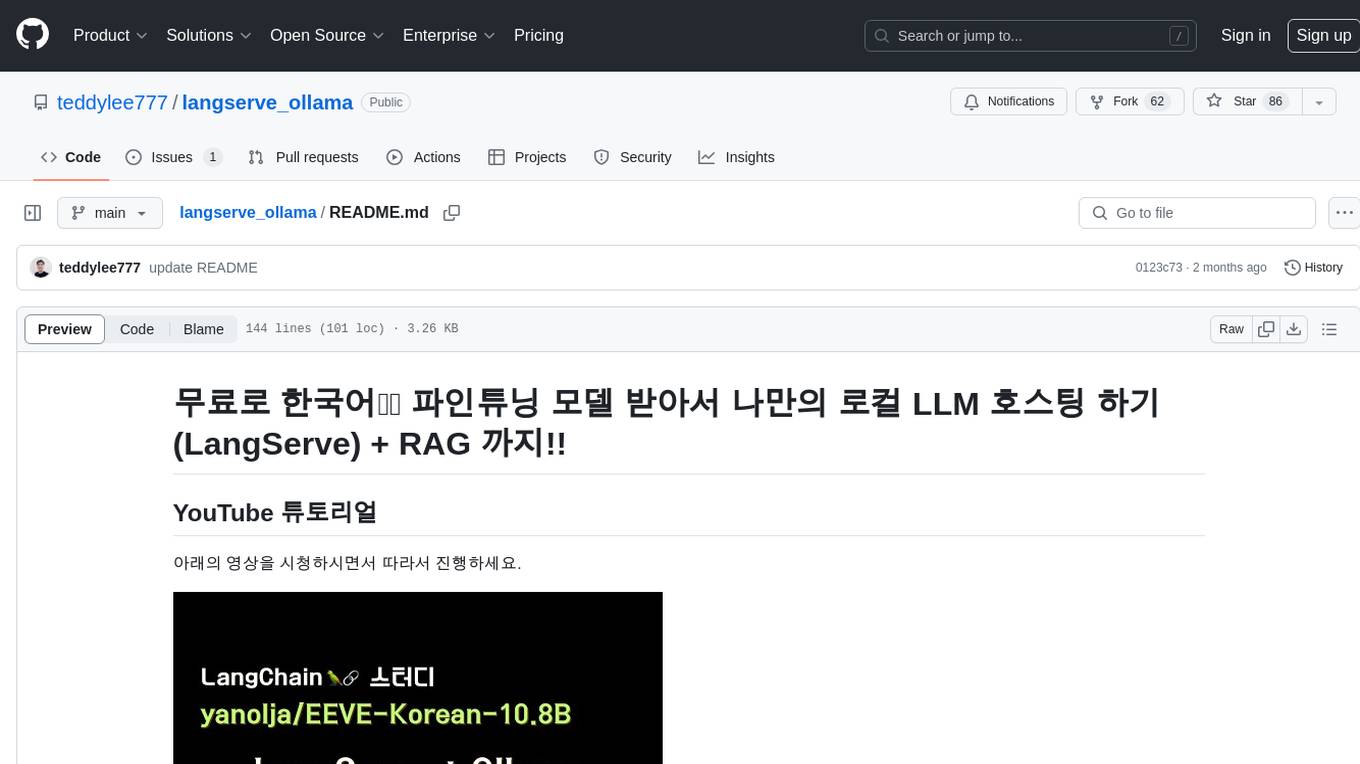
langserve_ollama
LangServe Ollama is a tool that allows users to fine-tune Korean language models for local hosting, including RAG. Users can load HuggingFace gguf files, create model chains, and monitor GPU usage. The tool provides a seamless workflow for customizing and deploying language models in a local environment.
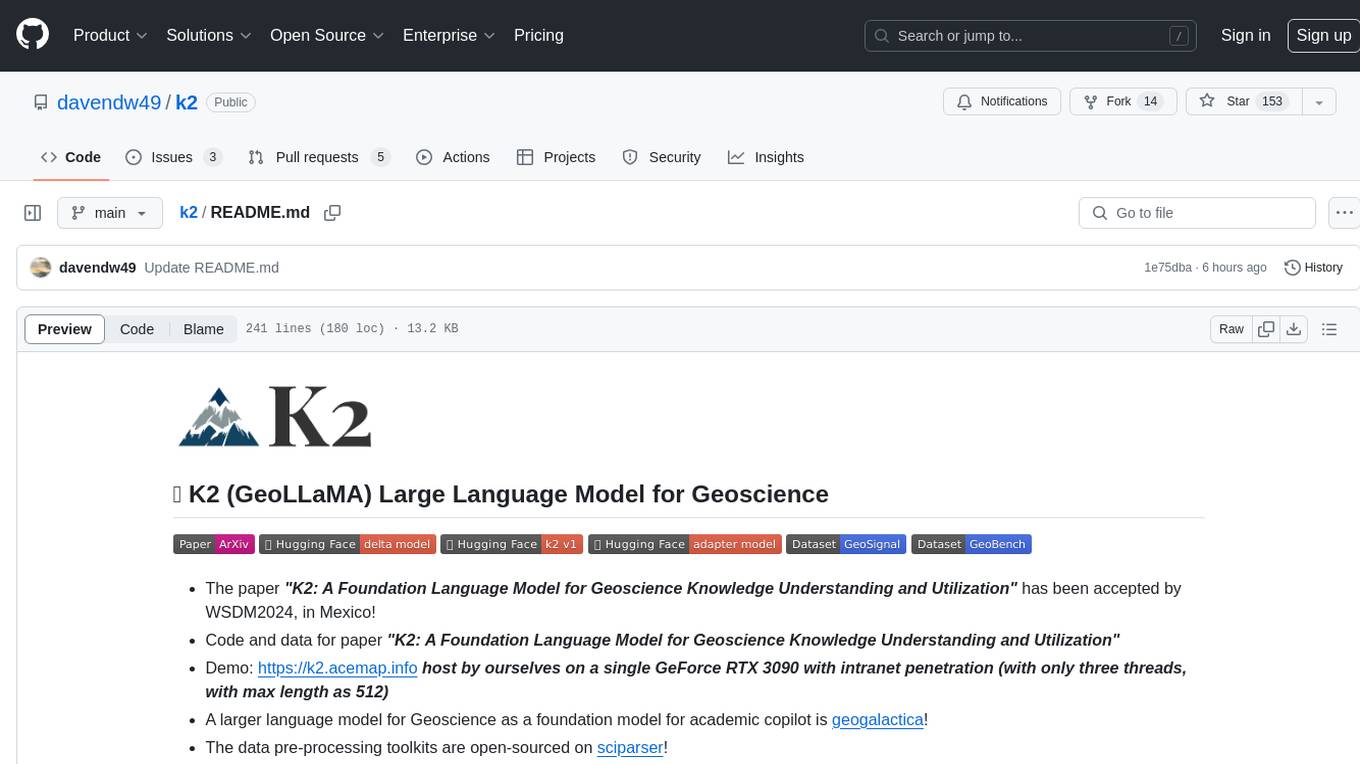
k2
K2 (GeoLLaMA) is a large language model for geoscience, trained on geoscience literature and fine-tuned with knowledge-intensive instruction data. It outperforms baseline models on objective and subjective tasks. The repository provides K2 weights, core data of GeoSignal, GeoBench benchmark, and code for further pretraining and instruction tuning. The model is available on Hugging Face for use. The project aims to create larger and more powerful geoscience language models in the future.
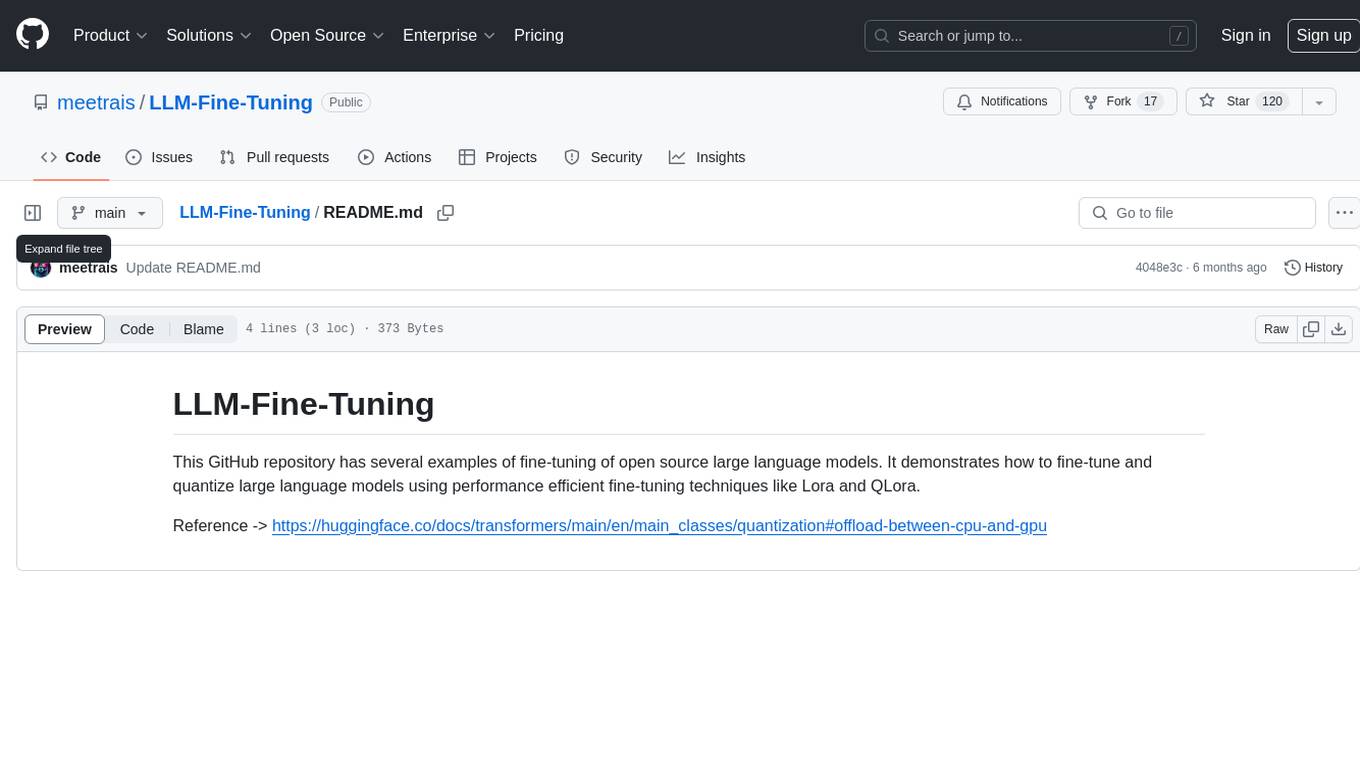
LLM-Fine-Tuning
This GitHub repository contains examples of fine-tuning open source large language models. It showcases the process of fine-tuning and quantizing large language models using efficient techniques like Lora and QLora. The repository serves as a practical guide for individuals looking to optimize the performance of language models through fine-tuning.
For similar jobs
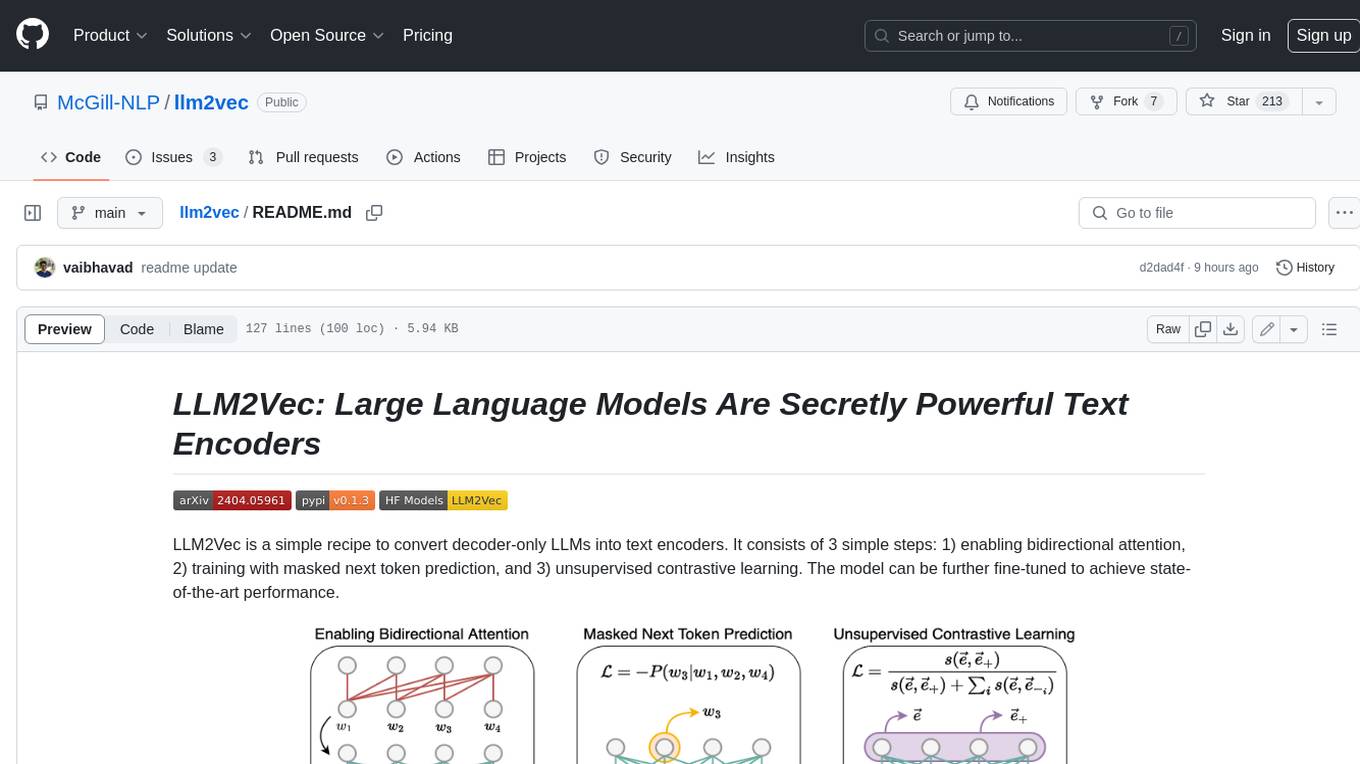
llm2vec
LLM2Vec is a simple recipe to convert decoder-only LLMs into text encoders. It consists of 3 simple steps: 1) enabling bidirectional attention, 2) training with masked next token prediction, and 3) unsupervised contrastive learning. The model can be further fine-tuned to achieve state-of-the-art performance.
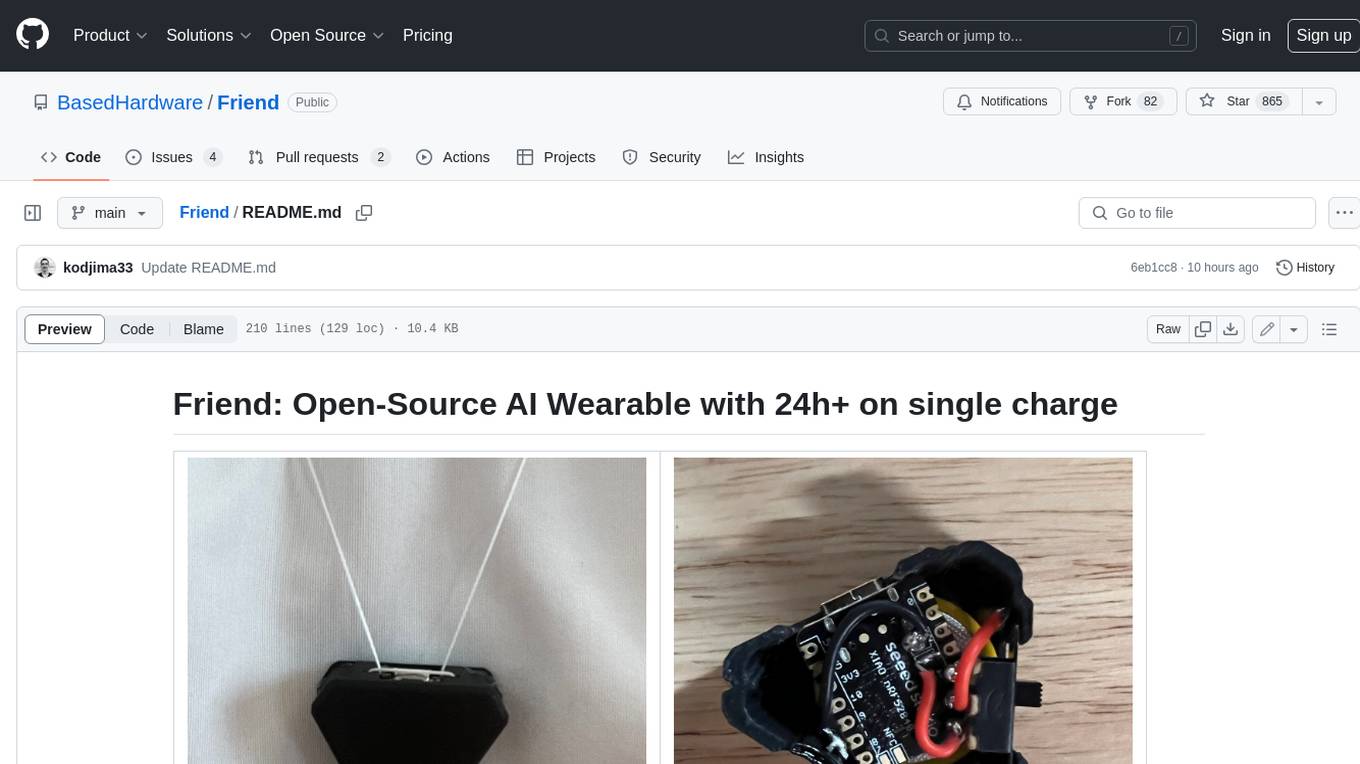
Friend
Friend is an open-source AI wearable device that records everything you say, gives you proactive feedback and advice. It has real-time AI audio processing capabilities, low-powered Bluetooth, open-source software, and a wearable design. The device is designed to be affordable and easy to use, with a total cost of less than $20. To get started, you can clone the repo, choose the version of the app you want to install, and follow the instructions for installing the firmware and assembling the device. Friend is still a prototype project and is provided "as is", without warranty of any kind. Use of the device should comply with all local laws and regulations concerning privacy and data protection.
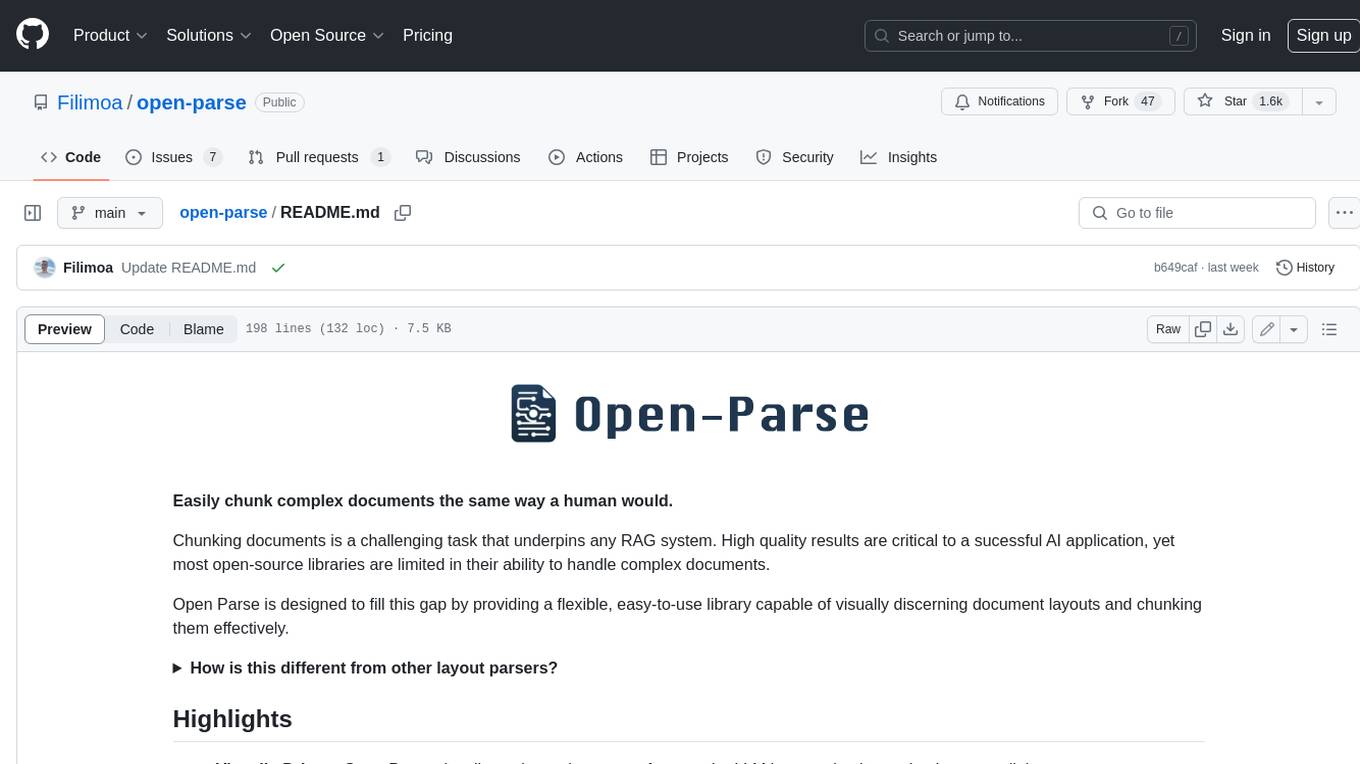
open-parse
Open Parse is a Python library for visually discerning document layouts and chunking them effectively. It is designed to fill the gap in open-source libraries for handling complex documents. Unlike text splitting, which converts a file to raw text and slices it up, Open Parse visually analyzes documents for superior LLM input. It also supports basic markdown for parsing headings, bold, and italics, and has high-precision table support, extracting tables into clean Markdown formats with accuracy that surpasses traditional tools. Open Parse is extensible, allowing users to easily implement their own post-processing steps. It is also intuitive, with great editor support and completion everywhere, making it easy to use and learn.

RLHF-Reward-Modeling
This repository contains code for training reward models for Deep Reinforcement Learning-based Reward-modulated Hierarchical Fine-tuning (DRL-based RLHF), Iterative Selection Fine-tuning (Rejection sampling fine-tuning), and iterative Decision Policy Optimization (DPO). The reward models are trained using a Bradley-Terry model based on the Gemma and Mistral language models. The resulting reward models achieve state-of-the-art performance on the RewardBench leaderboard for reward models with base models of up to 13B parameters.
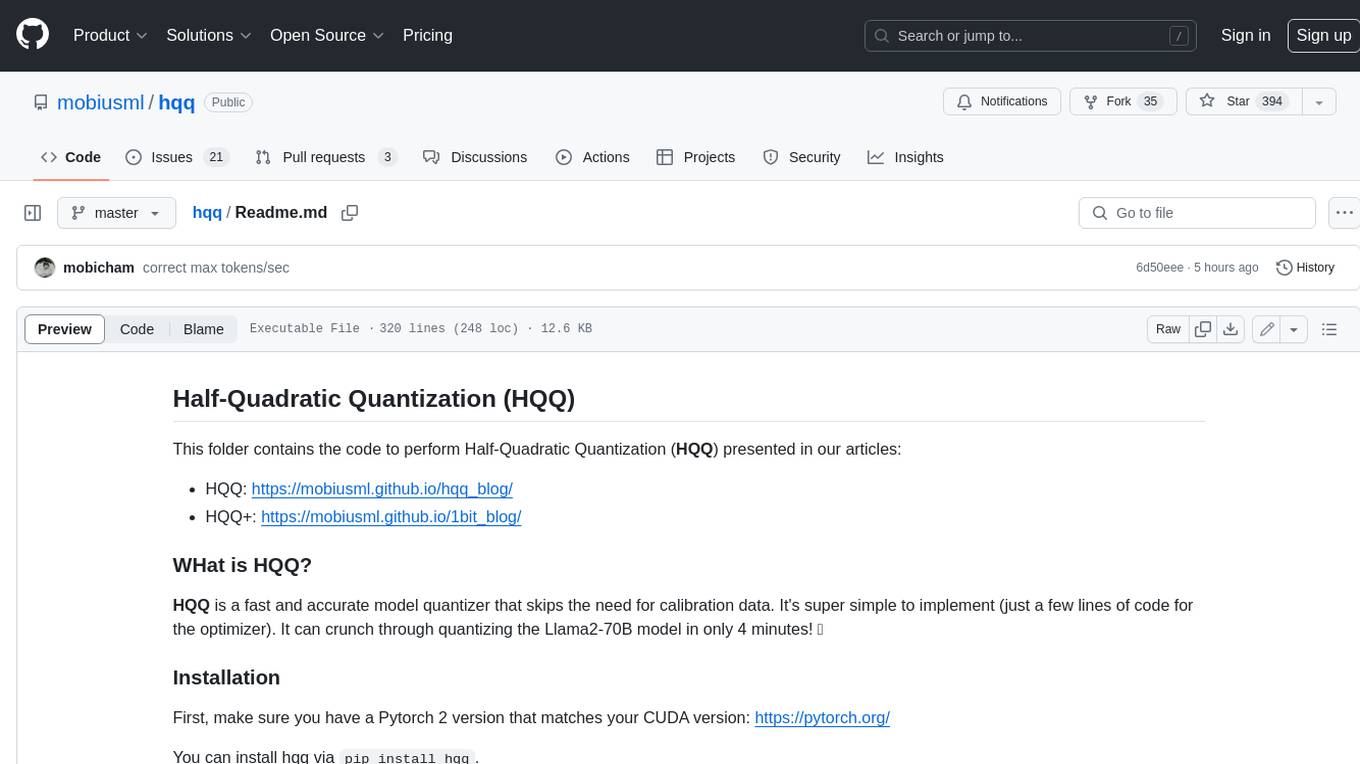
hqq
HQQ is a fast and accurate model quantizer that skips the need for calibration data. It's super simple to implement (just a few lines of code for the optimizer). It can crunch through quantizing the Llama2-70B model in only 4 minutes! 🚀

curated-transformers
Curated Transformers is a transformer library for PyTorch that provides state-of-the-art models composed of reusable components. It supports various transformer architectures, including encoders like ALBERT, BERT, and RoBERTa, and decoders like Falcon, Llama, and MPT. The library emphasizes consistent type annotations, minimal dependencies, and ease of use for education and research. It has been production-tested by Explosion and will be the default transformer implementation in spaCy 3.7.
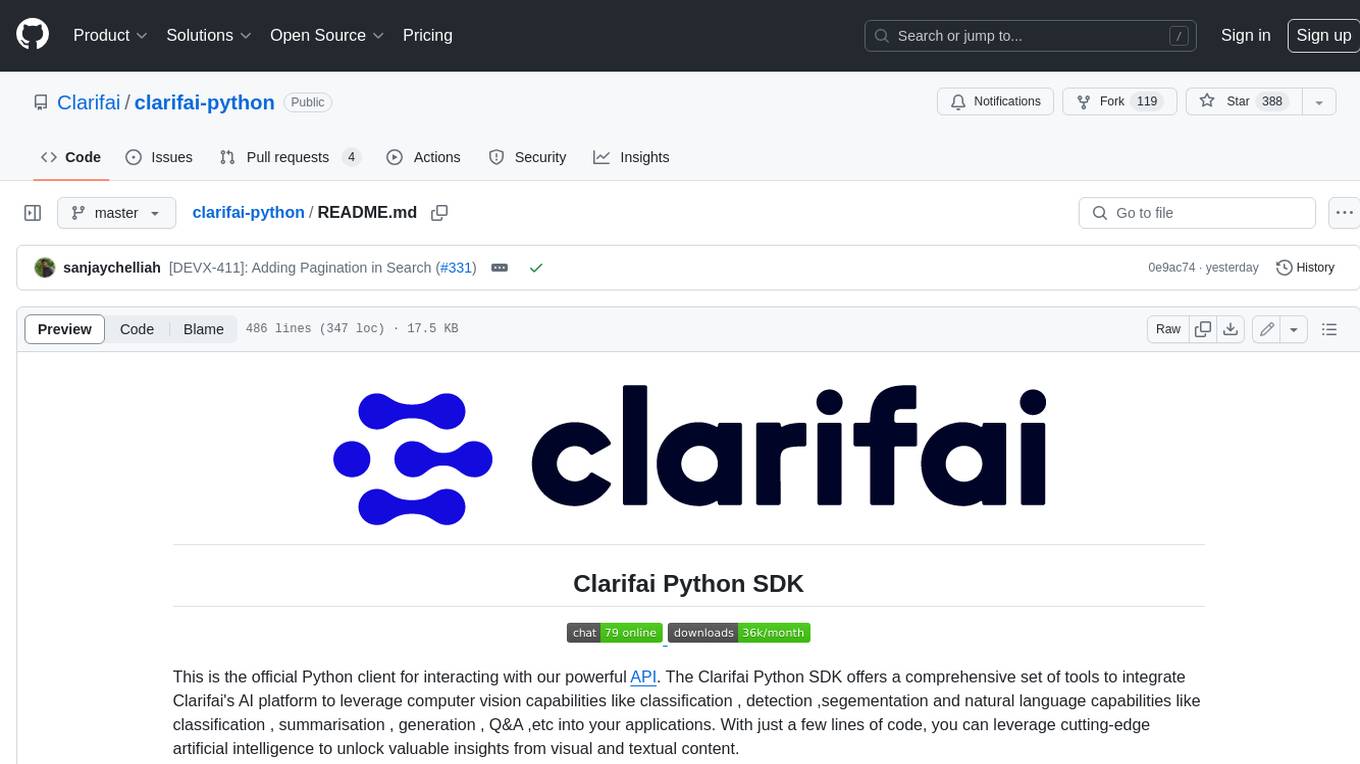
clarifai-python
The Clarifai Python SDK offers a comprehensive set of tools to integrate Clarifai's AI platform to leverage computer vision capabilities like classification , detection ,segementation and natural language capabilities like classification , summarisation , generation , Q&A ,etc into your applications. With just a few lines of code, you can leverage cutting-edge artificial intelligence to unlock valuable insights from visual and textual content.
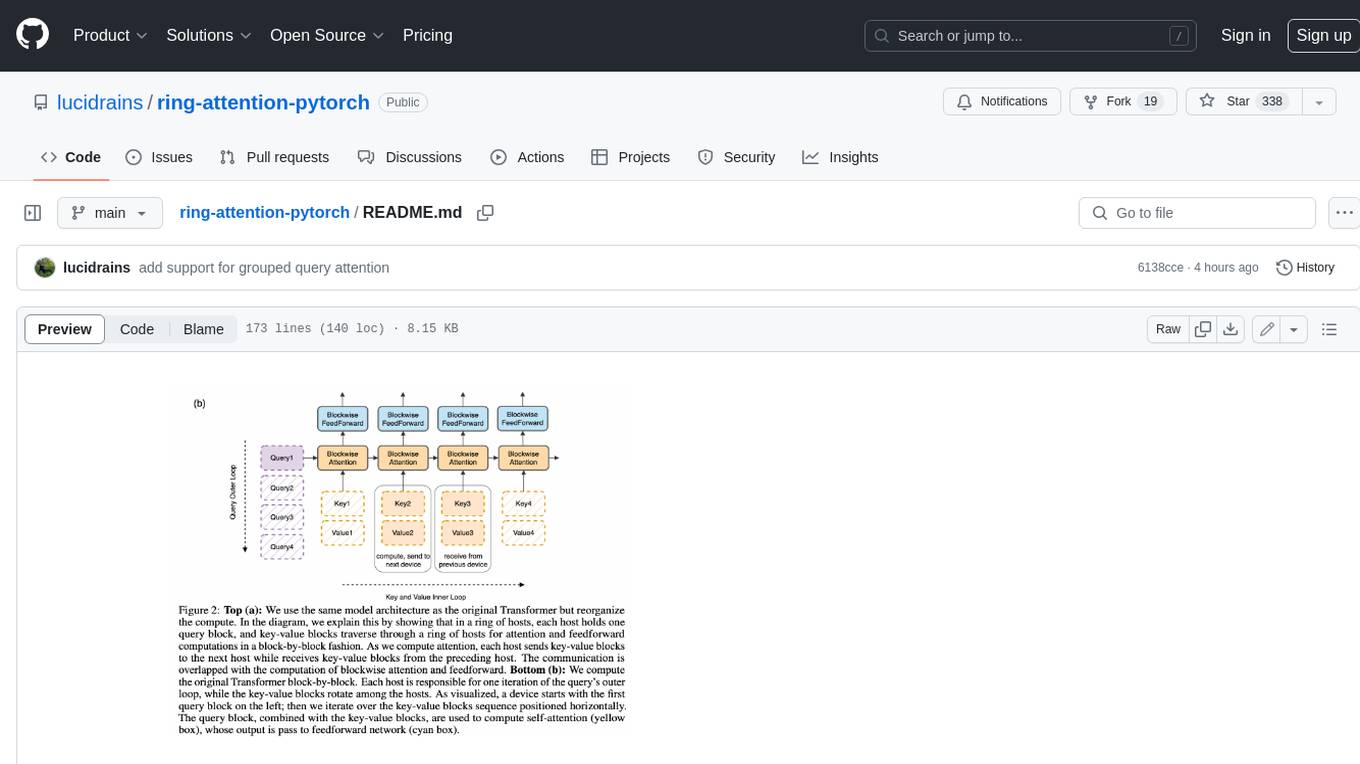
ring-attention-pytorch
This repository contains an implementation of Ring Attention, a technique for processing large sequences in transformers. Ring Attention splits the data across the sequence dimension and applies ring reduce to the processing of the tiles of the attention matrix, similar to flash attention. It also includes support for Striped Attention, a follow-up paper that permutes the sequence for better workload balancing for autoregressive transformers, and grouped query attention, which saves on communication costs during the ring reduce. The repository includes a CUDA version of the flash attention kernel, which is used for the forward and backward passes of the ring attention. It also includes logic for splitting the sequence evenly among ranks, either within the attention function or in the external ring transformer wrapper, and basic test cases with two processes to check for equivalent output and gradients.